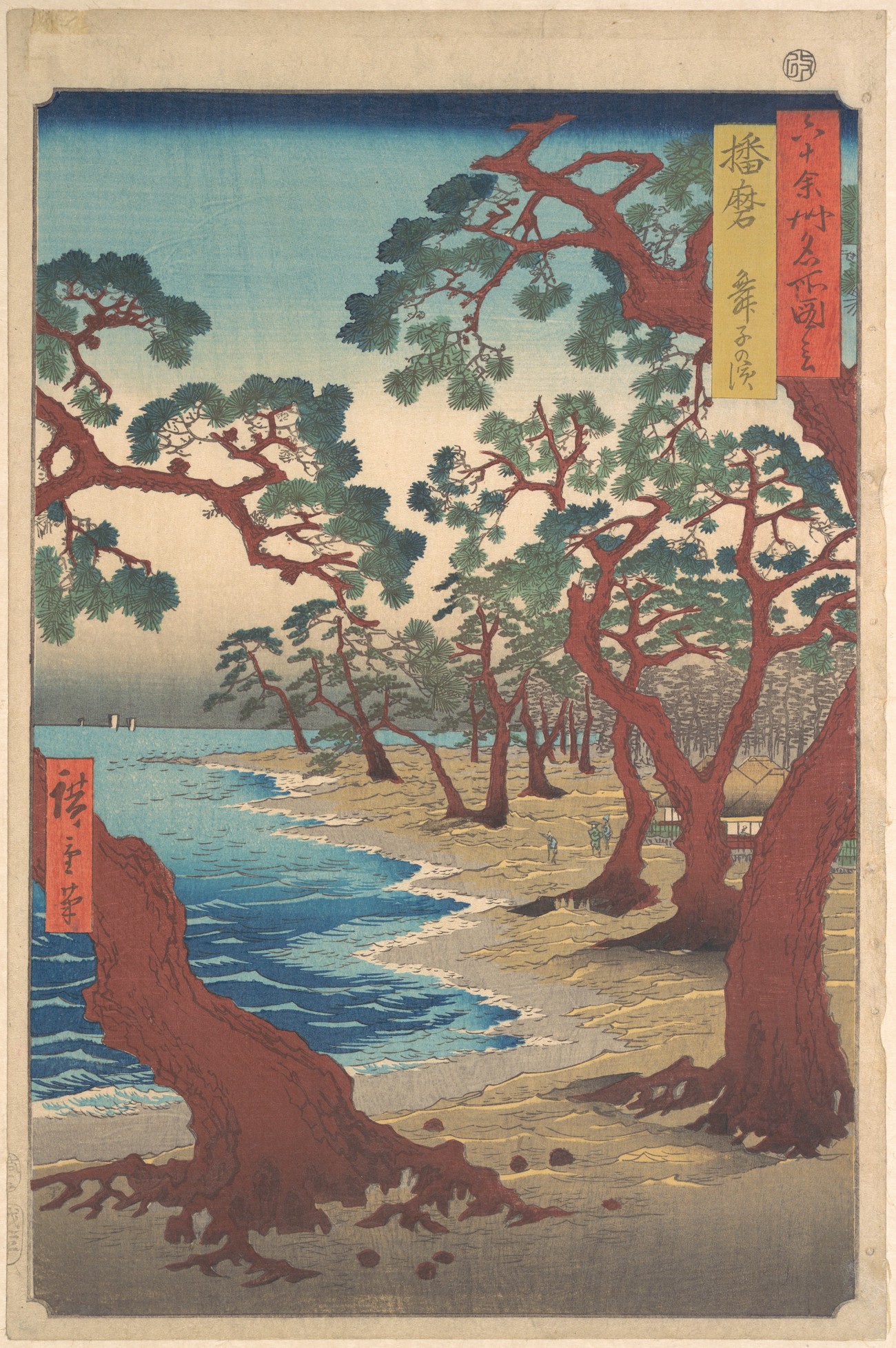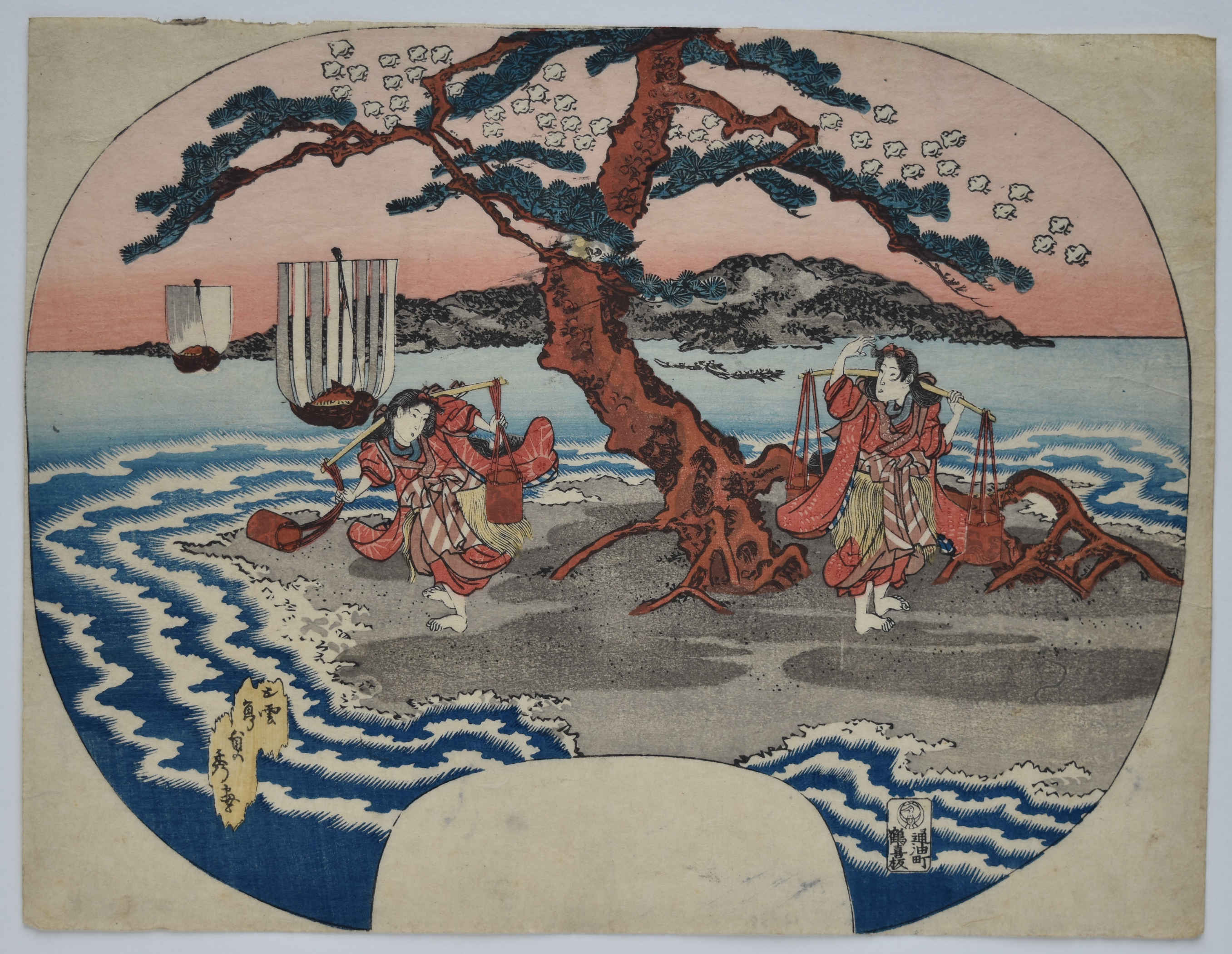 See also Maiko Beach, Harima Province, from the series Views of Famous Places in the Sixty-Odd Provinces,
See also Maiko Beach, Harima Province, from the series Views of Famous Places in the Sixty-Odd Provinces,
-
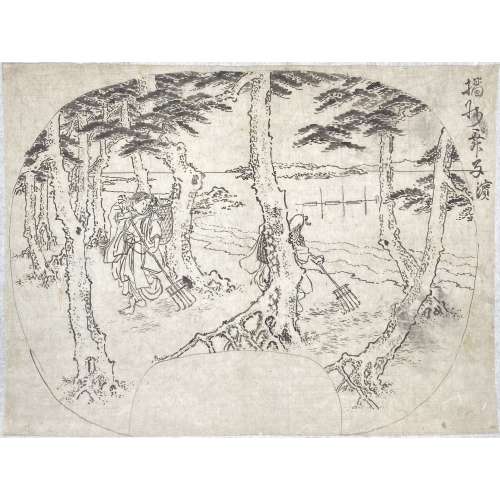 Artist: Veronica Miller attributes the drawing to Utagawa Sadahide [歌川 貞秀] (Japanese, 1807 – 1879), also known as Gountei Sadahide [五雲亭 貞秀]. A preparatory drawing for a fan print depicts two women raking pine needles along the scenic beach at Harima. Inscription at top right "Maiko Beach in Harima" (Harima Maiko no Hama) [播磨 舞子濱], which is now located in Hyōgo Prefecture. The view must be of the Akashi Strait, looking towards Awaji Island. Drawn on thin hanshita paper, mounted lightly at the top to a backing paper, but unbacked. Size: 240 x 319 mm. Attribution to Sadahide based on his design titled "Suma Bay: Matsukaze and Murasame" (see below):
Artist: Veronica Miller attributes the drawing to Utagawa Sadahide [歌川 貞秀] (Japanese, 1807 – 1879), also known as Gountei Sadahide [五雲亭 貞秀]. A preparatory drawing for a fan print depicts two women raking pine needles along the scenic beach at Harima. Inscription at top right "Maiko Beach in Harima" (Harima Maiko no Hama) [播磨 舞子濱], which is now located in Hyōgo Prefecture. The view must be of the Akashi Strait, looking towards Awaji Island. Drawn on thin hanshita paper, mounted lightly at the top to a backing paper, but unbacked. Size: 240 x 319 mm. Attribution to Sadahide based on his design titled "Suma Bay: Matsukaze and Murasame" (see below): See also Maiko Beach, Harima Province, from the series Views of Famous Places in the Sixty-Odd Provinces,
See also Maiko Beach, Harima Province, from the series Views of Famous Places in the Sixty-Odd Provinces,
-
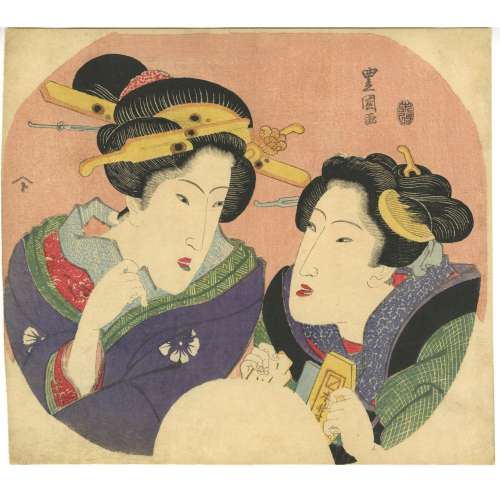 Artist: Utagawa Toyokuni I [歌川豊国] (1769–1825). Pubisher: Enshūya Matabei (遠州屋又兵衛) (c. 1768 – 1881), seal name: Enmata [ 遠又]. Signed: Toyokuni ga [豊国画]. Date-aratame censor seal: 未改, Bunsei 6 (1823). Size: uchiwa-e; 233 x 262 mm. Ref: Israel Goldman. Japanese Prints, Paintings and Books / Catalogue 28, 2022: № 14.
Artist: Utagawa Toyokuni I [歌川豊国] (1769–1825). Pubisher: Enshūya Matabei (遠州屋又兵衛) (c. 1768 – 1881), seal name: Enmata [ 遠又]. Signed: Toyokuni ga [豊国画]. Date-aratame censor seal: 未改, Bunsei 6 (1823). Size: uchiwa-e; 233 x 262 mm. Ref: Israel Goldman. Japanese Prints, Paintings and Books / Catalogue 28, 2022: № 14. -
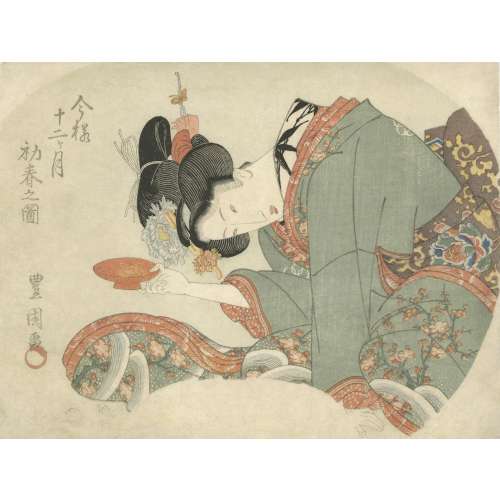 Title: Early Spring [初春之図] (Hatsuharu no zu); Series: Fashionable Twelve Months [今様十二ヶ月] (Imayo juni-kagetsu). Another version of translation: Modern Beauties of Twelve Months. Artist: Utagawa Toyokuni I [歌川豊国] (1769–1825). Pubisher: Ibaya Senzaburō [伊場屋仙三郎] (Japanese, 1815 – 1869), seal: Dansendō [伊場仙]. Signed: Toyokuni ga [豊国画] and sealed with toshidama. Date-kiwame seal: Ushi (ox), Bunsei 5 (1822). Size: double-sheet uncut fan print ( aiban uchiwa-e), each 217 x 288 mm. Ref: Tokyo Museum Collection.
Title: Early Spring [初春之図] (Hatsuharu no zu); Series: Fashionable Twelve Months [今様十二ヶ月] (Imayo juni-kagetsu). Another version of translation: Modern Beauties of Twelve Months. Artist: Utagawa Toyokuni I [歌川豊国] (1769–1825). Pubisher: Ibaya Senzaburō [伊場屋仙三郎] (Japanese, 1815 – 1869), seal: Dansendō [伊場仙]. Signed: Toyokuni ga [豊国画] and sealed with toshidama. Date-kiwame seal: Ushi (ox), Bunsei 5 (1822). Size: double-sheet uncut fan print ( aiban uchiwa-e), each 217 x 288 mm. Ref: Tokyo Museum Collection.
Other five prints of this series: SVJP 0326.2020; SVJP-0362.2022; SVJP-0363.2022; SVJP-0364.2022; SVJP-0365.2022.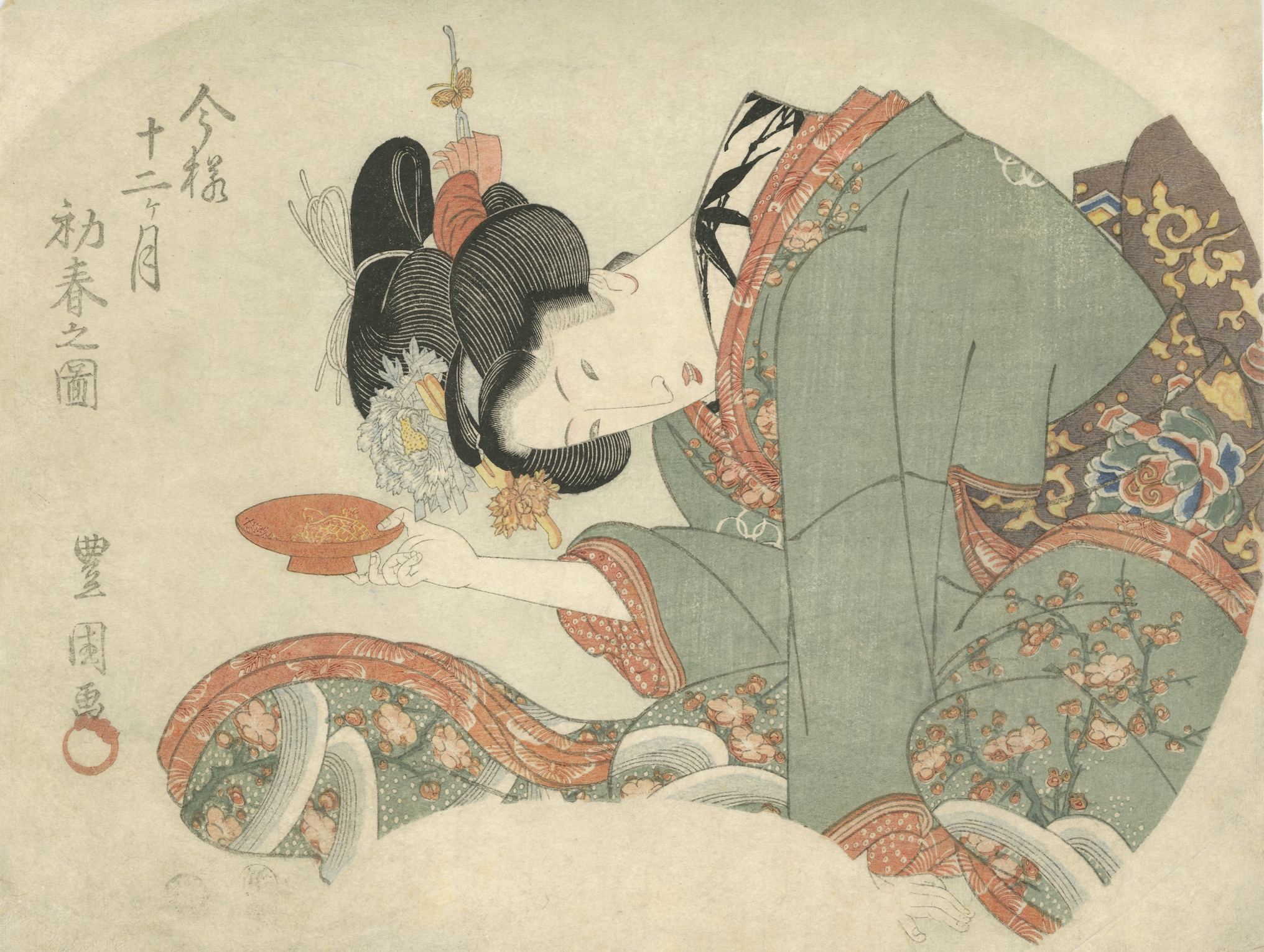
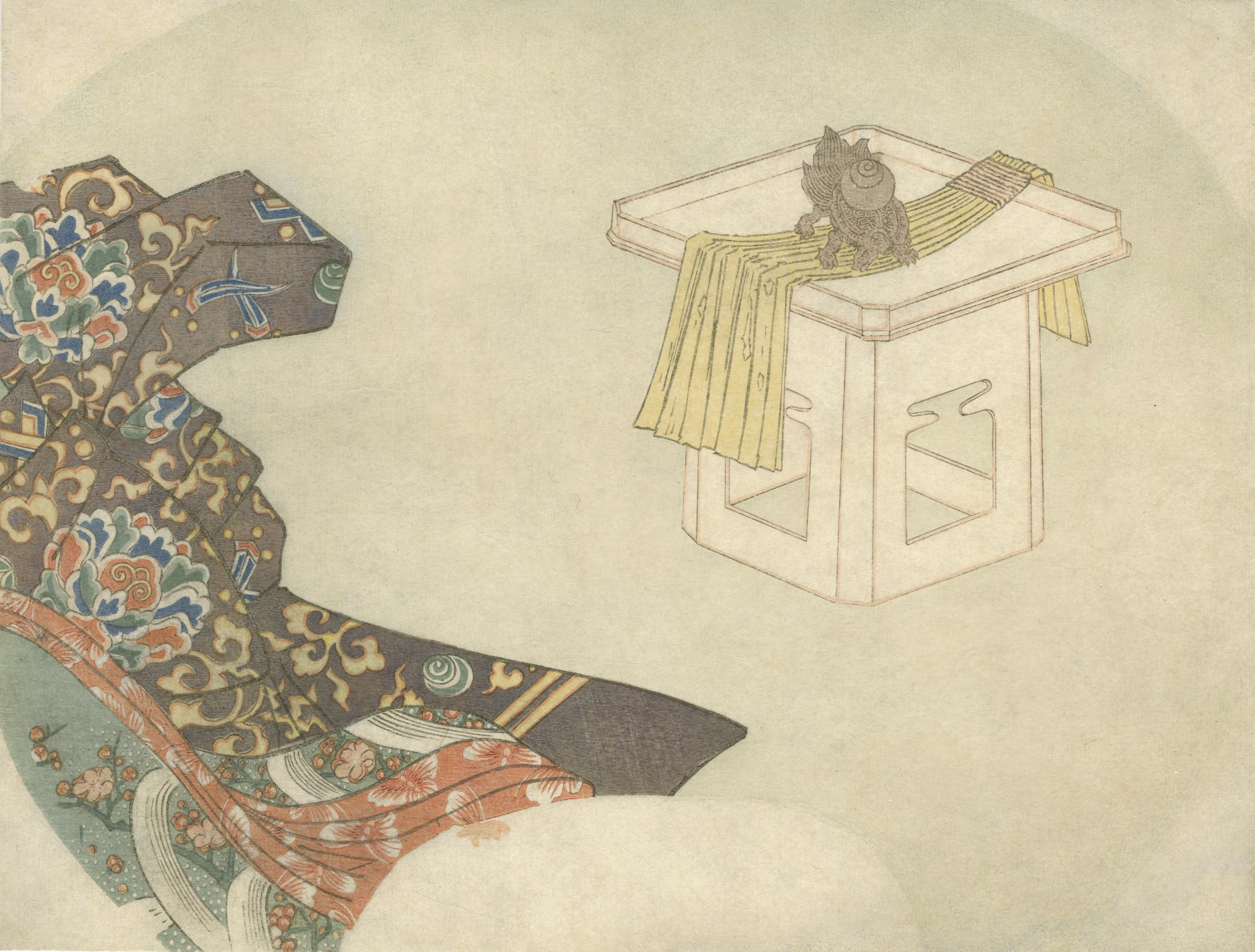
-
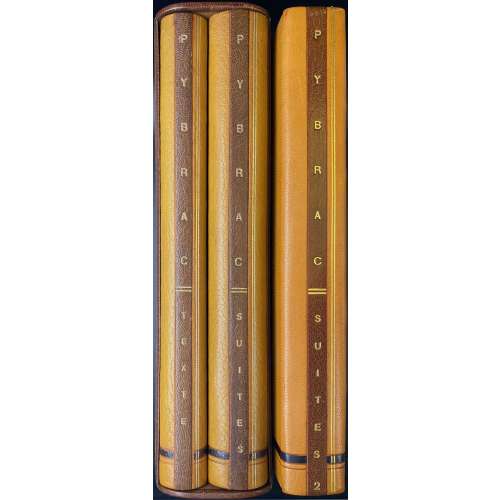 A three-volume unique copy of Louÿs’s poetical work ‘Pybrac’; edition published in 1928 by Marcel Vertès limited to 30 copies; contains 31 drypoints by Marcel Vertès, incl. frontispiece, nine full-page plates and twenty in-text vignettes; enriched with a volume of three suites of plates (first state b/w on Van Gelder paper, final state b/w on Japon nacré paper, final state hand-coloured on Van Gelder paper) plus 5 refused plates; and with a volume of one original watercolour, five ink drawings, three suites of plates (first state b/w on Van Gelder paper, final state b/w on Japon nacré paper, final state hand-coloured on Van Gelder paper) plus similar 5 refused plates, one b/w plate and one coloured plate, and a drypoint metal plate; two volumes of three are in a slipcase. Same edition in this collection: LIB-2919.2022. Details: (1) The ‘Texte’ volume, collated in-4to, 26 x 20.5 cm bound by Creuzevault (signed inside the front cover, in the bottom) in full tan morocco, blind fillets and a brown strip in the bottom to boards, double gilt fillet and a brown label along the spine, gilt-lettered vertically “PYBRAC | TEXTE”; gilt on black faux marbled endpapers, printed on watermarked Van Gelder Zonen laid paper; collated as follows: [3] blank flyleaves, [1] wrapper ‘PYBRAC’, [5] leaves with pasted original ink drawings on white paper, [1] leaf with pasted original hand-coloured ink drawings on blue paper, [1] drypoint frontispiece, [2] blank leaves, [1] half-title/limitation, [1] t.p., [2] blank leaves, 1-104 (pp. 1-78 [2]), [4] blank leaves plus nine full-page drypoint plates; total 70 leaves. Title-page: PYBRAC | ILLUSTRE DE TRENTE POINT SÈCHES | D’UN | ARTISTE INCONNU | PARIS | AUX DÉPENS D’UN AMATEUR | — | M. CM. XXVIII || Limitation: Edition limited to 30 copies; 1 copy unique on Japon Nacré with 30 original sketches, one suite in colour, two suites in black and 5 cancelled plates; 29 copies on Hollande Van Gelder, with one original watercolour, four original sketches, one suite in colour, two suites in black and 5 cancelled plates. This is copy № 12. (2) The ‘Suites’ volume, 26 x 20.5 cm, uniformly bound in quarter tan morocco over faux marbled paper, blind fillets, horizontal brown strip in the bottom, a vertical brown strip along the border, double gilt fillet and a brown label along the spine, gilt-lettered vertically “PYBRAC | SUITES”; gilt on black faux marbled endpapers; collated as follows: [3] blank flyleaves, three suites of prints: first state on Van Gelder paper, the final state on ‘Japon nacré’ paper, and hand-coloured final state on Van Gelder (31 x 3 = 93 leaves) plus [5] refused plates and [3] blank leaves; total 104 leaves. ‘Texte’ and ‘Suites’ volumes are placed in a faux marbled slipcase. (3) The ‘Suites 2’ volume, 26 x 21.5 cm, bound similarly to the ‘Suites’ volume (quarter morocco), gilt-lettered vertically “PYBRAC | SUITES 2” to spine; front cover with a hollow placement with the drypoint metal plate inside (plate #3), [3] blank wove paper leaves, [1] section title (s.t.) ‘AQUARELLE ORIGINALE’, [1] ink and crayon drawing, [1] s.t. ‘CROQUIS ORIGINAUX’, [5] ink drawings, [1] s.t. ‘PREMIER ÉTAT DES PLANCHES’, [31] plates on Van Gelder, [1] s.t. ‘SUITE EN NOIR SUR JAPON NACRÉ’, [31] plates, s.t. ‘SUITE COLORIÉE A LA MAIN’, [31] plates, [1] s.t. ‘PLANCHES REFUSÉS’, [5] plates, [1] coloured plate #13, [1] uncoloured plate #10, [3] wove paper blank leaves; total 118 leaves. Catalogue raisonné: Dutel (1920-70) № 2279 ; Fekete № 216; Nordmann (I) № 235; Vokaer 23. Ref.: honesterotica.com Contributors: Pierre Louÿs (French, 1870 – 1925) – author. Marcel Vertès [Marcell Vértes] (Jewish-Hungarian-French, 1895 – 1961) – artist. Henri Creuzevault (French, 1905 – 1971) – bookbinder. Seller's description: [ENRICHI & HORS-COMMERCE NON JUSTIFIÉ] Pierre LOUŸS - Marcel VERTÈS. Pybrac, illustré de trente pointes sèches d’un artiste inconnu. Paris, aux dépens d’un amateur, 1928. 3 volumes in-4 de 79 pages, 98 et 76 feuillets. Le volume contenant le texte est relié d'un plein chagrin havane à dos lisse, une pièce de titre en long et un filet doré à froid en bas (Creuzevault). Les deux autres volumes sont reliés à l'identiques, demi chagrin havane, dos lisse, pièce de titre en long, filets dorés sur le dos et filet doré à froid sur le bas et le long du mors. Le cuivre est placé dans le plat intérieur du volume 3, les suites dans le 2. Les deux premiers volumes sont rassemblés dans un étui. Illustré de 31 gravures originales dont 11 hors-texte par Marcel Vertès pour l’une des premières publications obscènes de Pierre Louÿs. Tirage à 30 exemplaires. La justification indique : "Il a été tiré de ce livre 30 exemplaires : 1 exemplaire unique sur Japon nacré avec trente croquis originaux, une suite en couleur, deux suites en noir et une épreuve des cinq planches refusées ; 29 exemplaires sur grand papier de Hollande Van Gelder avec une aquarelle originale, quatre croquis originaux, une suite en couleur, deux suites en noir et une épreuve des cinq planches refusées.". Exemplaire n°12 (Volume 1 Texte). Cet exemplaire est composé différemment soit : Volume 1, Texte : La couverture conservée, 5 dessins originaux à l'encre, 1 dessin sur papier bleu à l'estompe de couleur, le texte, les gravures in-texte et hors-texte. — Volume 2, Suites : les 31 planches en 3 états (1 en couleur et 2 en noir) et une épreuve des 5 planches refusées. — Volume 3, Suites 2 : 1 cuivre, 1 aquarelle, 5 dessins originaux à l'encre, 2 suites en noir, 1 suite coloriée à la main, 1 épreuve des 5 planches refusées, 1 dessin refusé à l'encre et à l'aquarelle et 1 dessin refusé à l'encre. Dutel précise : « Elle est ornée de 11 gravures originales hors-texte dont un titre et 20 gravures dans le texte par Marcel Vertès qui fut aussi l’éditeur de cet ouvrage. Il s’agit d’une des plus belles et des plus rares productions bibliophiliques de l’artiste. » Et surtout la plus rare… (Dutel 2279, pas à l’Enfer de la BnF).
A three-volume unique copy of Louÿs’s poetical work ‘Pybrac’; edition published in 1928 by Marcel Vertès limited to 30 copies; contains 31 drypoints by Marcel Vertès, incl. frontispiece, nine full-page plates and twenty in-text vignettes; enriched with a volume of three suites of plates (first state b/w on Van Gelder paper, final state b/w on Japon nacré paper, final state hand-coloured on Van Gelder paper) plus 5 refused plates; and with a volume of one original watercolour, five ink drawings, three suites of plates (first state b/w on Van Gelder paper, final state b/w on Japon nacré paper, final state hand-coloured on Van Gelder paper) plus similar 5 refused plates, one b/w plate and one coloured plate, and a drypoint metal plate; two volumes of three are in a slipcase. Same edition in this collection: LIB-2919.2022. Details: (1) The ‘Texte’ volume, collated in-4to, 26 x 20.5 cm bound by Creuzevault (signed inside the front cover, in the bottom) in full tan morocco, blind fillets and a brown strip in the bottom to boards, double gilt fillet and a brown label along the spine, gilt-lettered vertically “PYBRAC | TEXTE”; gilt on black faux marbled endpapers, printed on watermarked Van Gelder Zonen laid paper; collated as follows: [3] blank flyleaves, [1] wrapper ‘PYBRAC’, [5] leaves with pasted original ink drawings on white paper, [1] leaf with pasted original hand-coloured ink drawings on blue paper, [1] drypoint frontispiece, [2] blank leaves, [1] half-title/limitation, [1] t.p., [2] blank leaves, 1-104 (pp. 1-78 [2]), [4] blank leaves plus nine full-page drypoint plates; total 70 leaves. Title-page: PYBRAC | ILLUSTRE DE TRENTE POINT SÈCHES | D’UN | ARTISTE INCONNU | PARIS | AUX DÉPENS D’UN AMATEUR | — | M. CM. XXVIII || Limitation: Edition limited to 30 copies; 1 copy unique on Japon Nacré with 30 original sketches, one suite in colour, two suites in black and 5 cancelled plates; 29 copies on Hollande Van Gelder, with one original watercolour, four original sketches, one suite in colour, two suites in black and 5 cancelled plates. This is copy № 12. (2) The ‘Suites’ volume, 26 x 20.5 cm, uniformly bound in quarter tan morocco over faux marbled paper, blind fillets, horizontal brown strip in the bottom, a vertical brown strip along the border, double gilt fillet and a brown label along the spine, gilt-lettered vertically “PYBRAC | SUITES”; gilt on black faux marbled endpapers; collated as follows: [3] blank flyleaves, three suites of prints: first state on Van Gelder paper, the final state on ‘Japon nacré’ paper, and hand-coloured final state on Van Gelder (31 x 3 = 93 leaves) plus [5] refused plates and [3] blank leaves; total 104 leaves. ‘Texte’ and ‘Suites’ volumes are placed in a faux marbled slipcase. (3) The ‘Suites 2’ volume, 26 x 21.5 cm, bound similarly to the ‘Suites’ volume (quarter morocco), gilt-lettered vertically “PYBRAC | SUITES 2” to spine; front cover with a hollow placement with the drypoint metal plate inside (plate #3), [3] blank wove paper leaves, [1] section title (s.t.) ‘AQUARELLE ORIGINALE’, [1] ink and crayon drawing, [1] s.t. ‘CROQUIS ORIGINAUX’, [5] ink drawings, [1] s.t. ‘PREMIER ÉTAT DES PLANCHES’, [31] plates on Van Gelder, [1] s.t. ‘SUITE EN NOIR SUR JAPON NACRÉ’, [31] plates, s.t. ‘SUITE COLORIÉE A LA MAIN’, [31] plates, [1] s.t. ‘PLANCHES REFUSÉS’, [5] plates, [1] coloured plate #13, [1] uncoloured plate #10, [3] wove paper blank leaves; total 118 leaves. Catalogue raisonné: Dutel (1920-70) № 2279 ; Fekete № 216; Nordmann (I) № 235; Vokaer 23. Ref.: honesterotica.com Contributors: Pierre Louÿs (French, 1870 – 1925) – author. Marcel Vertès [Marcell Vértes] (Jewish-Hungarian-French, 1895 – 1961) – artist. Henri Creuzevault (French, 1905 – 1971) – bookbinder. Seller's description: [ENRICHI & HORS-COMMERCE NON JUSTIFIÉ] Pierre LOUŸS - Marcel VERTÈS. Pybrac, illustré de trente pointes sèches d’un artiste inconnu. Paris, aux dépens d’un amateur, 1928. 3 volumes in-4 de 79 pages, 98 et 76 feuillets. Le volume contenant le texte est relié d'un plein chagrin havane à dos lisse, une pièce de titre en long et un filet doré à froid en bas (Creuzevault). Les deux autres volumes sont reliés à l'identiques, demi chagrin havane, dos lisse, pièce de titre en long, filets dorés sur le dos et filet doré à froid sur le bas et le long du mors. Le cuivre est placé dans le plat intérieur du volume 3, les suites dans le 2. Les deux premiers volumes sont rassemblés dans un étui. Illustré de 31 gravures originales dont 11 hors-texte par Marcel Vertès pour l’une des premières publications obscènes de Pierre Louÿs. Tirage à 30 exemplaires. La justification indique : "Il a été tiré de ce livre 30 exemplaires : 1 exemplaire unique sur Japon nacré avec trente croquis originaux, une suite en couleur, deux suites en noir et une épreuve des cinq planches refusées ; 29 exemplaires sur grand papier de Hollande Van Gelder avec une aquarelle originale, quatre croquis originaux, une suite en couleur, deux suites en noir et une épreuve des cinq planches refusées.". Exemplaire n°12 (Volume 1 Texte). Cet exemplaire est composé différemment soit : Volume 1, Texte : La couverture conservée, 5 dessins originaux à l'encre, 1 dessin sur papier bleu à l'estompe de couleur, le texte, les gravures in-texte et hors-texte. — Volume 2, Suites : les 31 planches en 3 états (1 en couleur et 2 en noir) et une épreuve des 5 planches refusées. — Volume 3, Suites 2 : 1 cuivre, 1 aquarelle, 5 dessins originaux à l'encre, 2 suites en noir, 1 suite coloriée à la main, 1 épreuve des 5 planches refusées, 1 dessin refusé à l'encre et à l'aquarelle et 1 dessin refusé à l'encre. Dutel précise : « Elle est ornée de 11 gravures originales hors-texte dont un titre et 20 gravures dans le texte par Marcel Vertès qui fut aussi l’éditeur de cet ouvrage. Il s’agit d’une des plus belles et des plus rares productions bibliophiliques de l’artiste. » Et surtout la plus rare… (Dutel 2279, pas à l’Enfer de la BnF). -
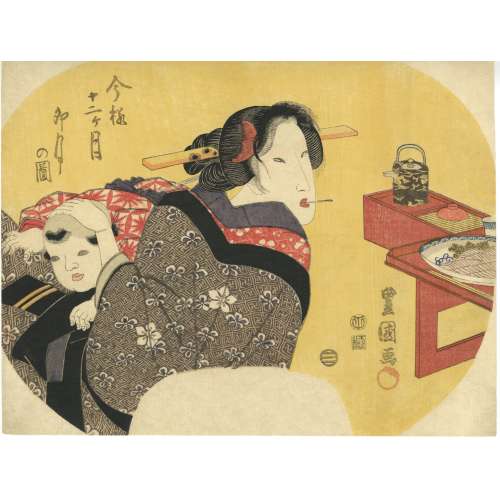 Title: Fourth lunar month [卯月] (Uzuki no zu); Series: Fashionable Twelve Months (Imayo juni-kagetsu). Another version of translation: Modern Beauties of Twelve Months. Artist: Utagawa Toyokuni I [歌川豊国] (1769–1825). Pubisher: Ibaya Senzaburō [伊場屋仙三郎] (Japanese, 1815 – 1869), seal: Dansendō [伊場仙]. Signed: Toyokuni ga and sealed with toshidama. Date-kiwame seal: Ushi (ox), Bunsei 5 (1822). Size: double-sheet uncut fan print ( aiban uchiwa-e), 219 x 295 mm.
Title: Fourth lunar month [卯月] (Uzuki no zu); Series: Fashionable Twelve Months (Imayo juni-kagetsu). Another version of translation: Modern Beauties of Twelve Months. Artist: Utagawa Toyokuni I [歌川豊国] (1769–1825). Pubisher: Ibaya Senzaburō [伊場屋仙三郎] (Japanese, 1815 – 1869), seal: Dansendō [伊場仙]. Signed: Toyokuni ga and sealed with toshidama. Date-kiwame seal: Ushi (ox), Bunsei 5 (1822). Size: double-sheet uncut fan print ( aiban uchiwa-e), 219 x 295 mm.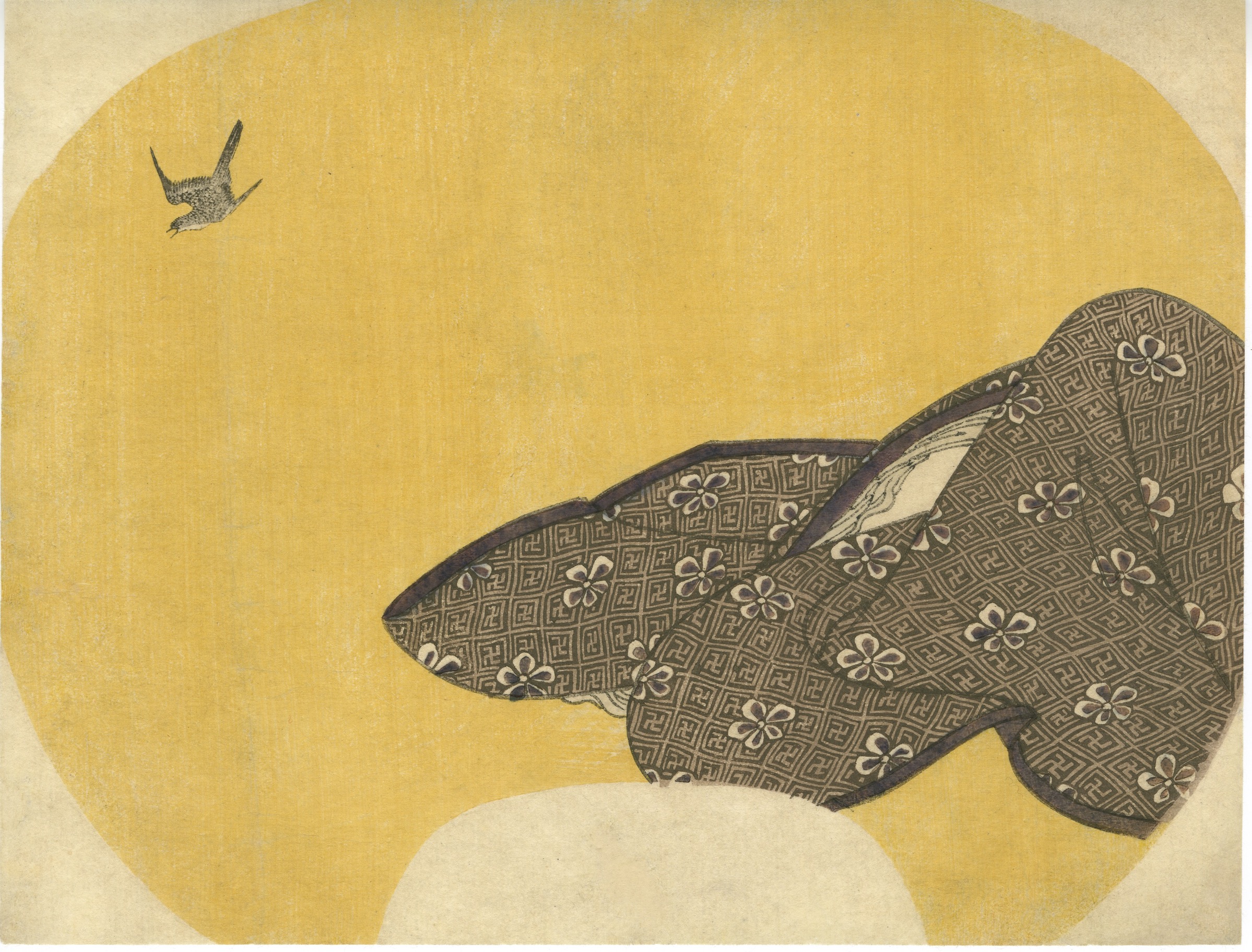
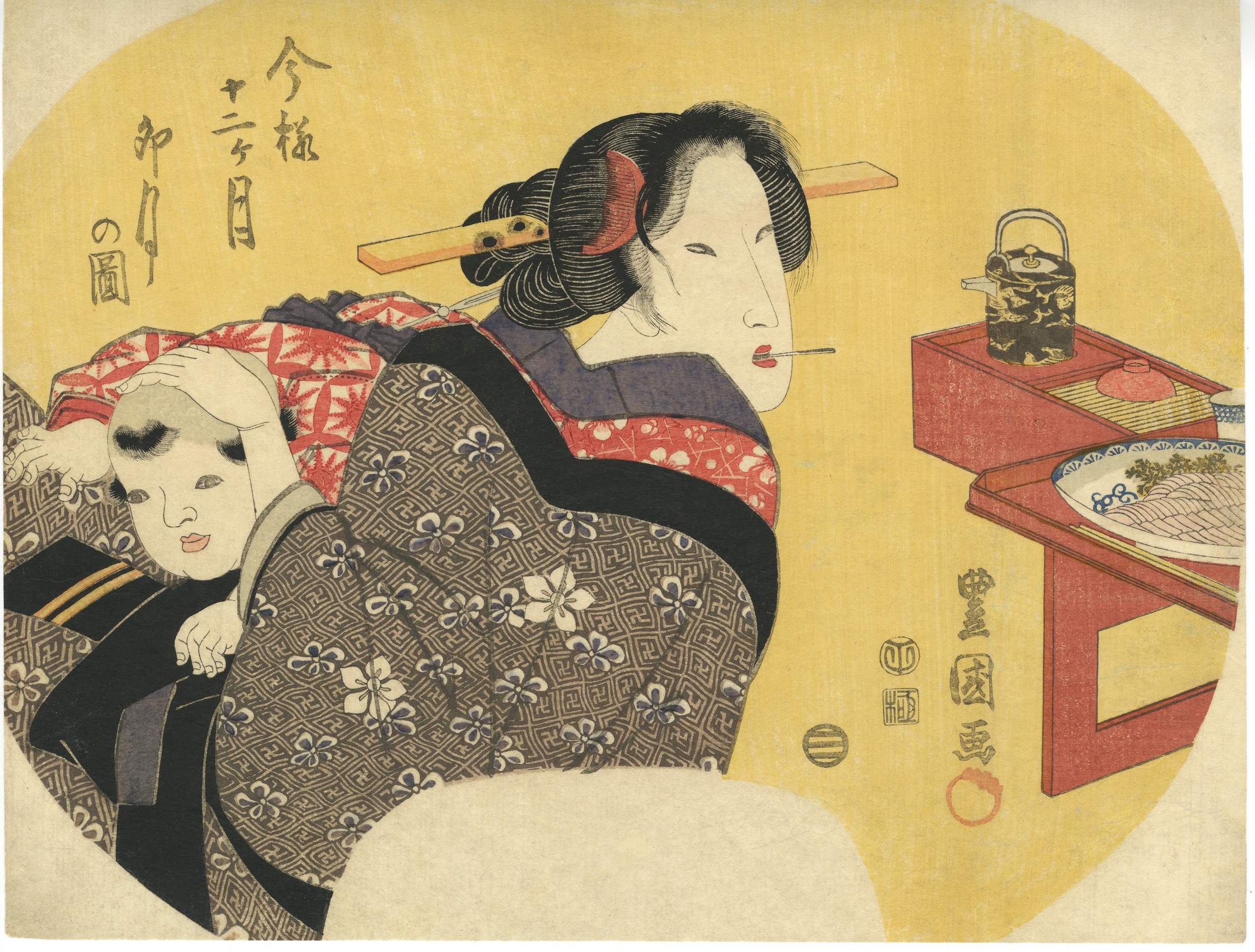
-
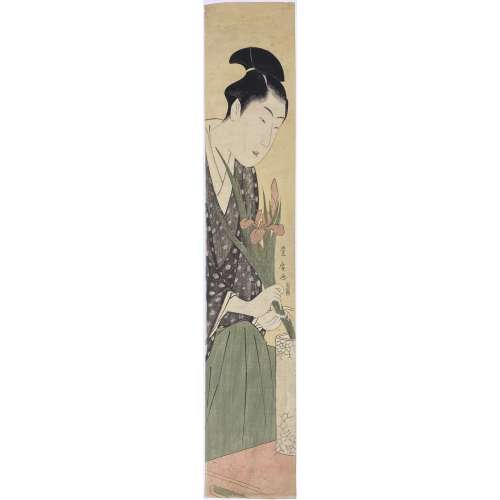 Artist: Utagawa Toyohiro [歌川豐廣] (Japanese, 1773 – 1828) Publisher: Takasu Soshichi (Marks 25-247 / 517) Size: pillar print (hashira-e), 69.2 x 13 cm.
Artist: Utagawa Toyohiro [歌川豐廣] (Japanese, 1773 – 1828) Publisher: Takasu Soshichi (Marks 25-247 / 517) Size: pillar print (hashira-e), 69.2 x 13 cm.Signed: Toyohiro ga [豐廣画]
Catalogue raisonné: Jacob Pins, The Japanese Pillar Print, № 923, p. 326. -
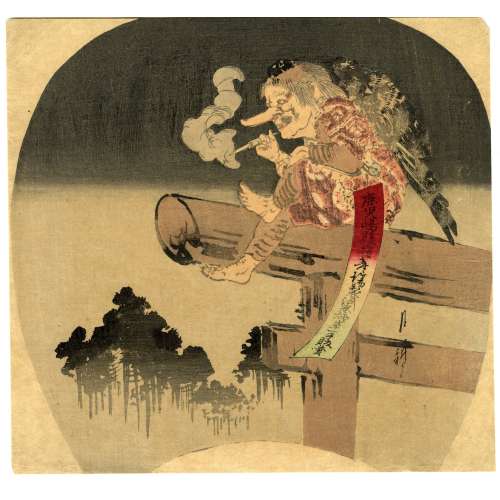 Ogata Gekkō [尾形月耕] (Japanese, 1859 – 1920). An uchiwa-e (fan-print) of advertisement of tobacco of Kagoshima Prefecture, c. 1890 (Meiji Period). Barefoot Tengu* is sitting on a torii (entrance to a Shinto shrine), smoking a cigarette through a mouthpiece. _______ * Tengu [天狗] (heavenly dog) is a type of legendary creature found in Japanese folk religion and are also considered a type of Shinto god (kami) or yōkai (supernatural beings).
Ogata Gekkō [尾形月耕] (Japanese, 1859 – 1920). An uchiwa-e (fan-print) of advertisement of tobacco of Kagoshima Prefecture, c. 1890 (Meiji Period). Barefoot Tengu* is sitting on a torii (entrance to a Shinto shrine), smoking a cigarette through a mouthpiece. _______ * Tengu [天狗] (heavenly dog) is a type of legendary creature found in Japanese folk religion and are also considered a type of Shinto god (kami) or yōkai (supernatural beings). -
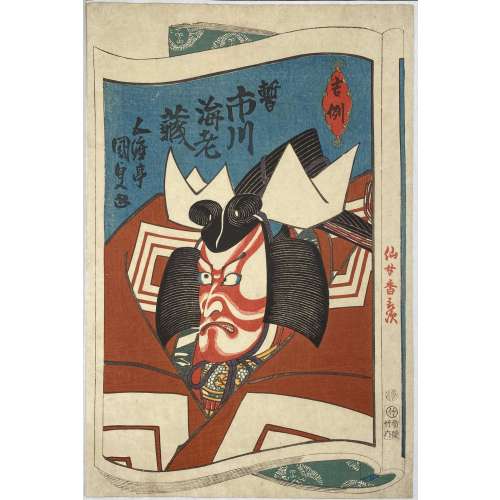 Ichikawa Ebizo V (1791 – 1859) a.k.a. Ichikawa Danjûrô VII was a great-great-great-son of Ichikawa Danjûrô I. He started his stage career in 1794, at the age of 4, playing in Shibaraku (the role he is depicted here). During his stage life, he played every role type. He was later banished from Edo for living too luxurious life for an actor. While in exile he flourished in Kioto and Osaka. Kichirei (Festive Annual Custom). Publisher: Takenouchi Magohachi (Hoeidô) Circa 1833. Description: 役者の舞台姿を描いた「舞台姿」シリーズと、日常図を描いた「千社詣」シリーズがあり、同じ役者が向かい合って対になる。(『五渡亭国貞』). Signed: Gototei Kunisada ga [五渡亭国貞画]. Censor's seal: kiwame 改印:極. Ref.: Shindo, Gototei Kunisada Yakusha-e no Sekai (1993), plate 88; Utagawa Kunisada, 150th Anniversary of His Death, Ota Memorial Museum, no. 169; MFA ACCESSION NUMBER 11.43128.
Ichikawa Ebizo V (1791 – 1859) a.k.a. Ichikawa Danjûrô VII was a great-great-great-son of Ichikawa Danjûrô I. He started his stage career in 1794, at the age of 4, playing in Shibaraku (the role he is depicted here). During his stage life, he played every role type. He was later banished from Edo for living too luxurious life for an actor. While in exile he flourished in Kioto and Osaka. Kichirei (Festive Annual Custom). Publisher: Takenouchi Magohachi (Hoeidô) Circa 1833. Description: 役者の舞台姿を描いた「舞台姿」シリーズと、日常図を描いた「千社詣」シリーズがあり、同じ役者が向かい合って対になる。(『五渡亭国貞』). Signed: Gototei Kunisada ga [五渡亭国貞画]. Censor's seal: kiwame 改印:極. Ref.: Shindo, Gototei Kunisada Yakusha-e no Sekai (1993), plate 88; Utagawa Kunisada, 150th Anniversary of His Death, Ota Memorial Museum, no. 169; MFA ACCESSION NUMBER 11.43128. -
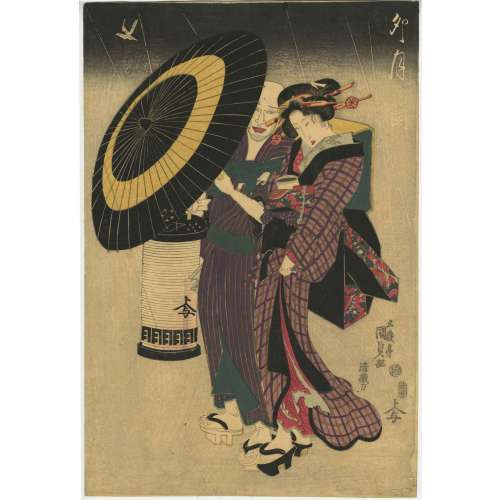 Utagawa Kunisada (Japanese: 歌川 国貞; also known as Utagawa Toyokuni III (三代歌川豊国); 1786 – 12 January 1865).
Utagawa Kunisada (Japanese: 歌川 国貞; also known as Utagawa Toyokuni III (三代歌川豊国); 1786 – 12 January 1865).A man with a shaved head (a monk), holding a paper lantern and an umbrella, walks with a young woman (a geisha) in the rain.
SIGNED: Gototei Kunisada ga [五渡亭国貞画]
Censor's seals: kiwame, futakata.
Blockcutter's mark: Seizô tô [改印:極、貳方]
MFA ACCESSION NUMBER 11.15150; MFA dating: about 1815–21 (Bunka 12–Bunsei 4);
Size: Vertical Ōban (382 x 260 mm). SOLD -
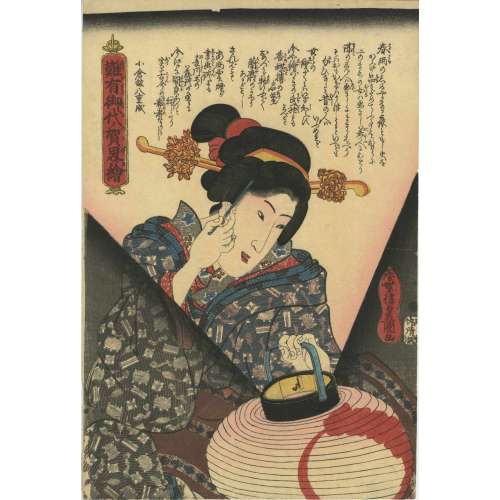 Utagawa Kunisada (Japanese: 歌川 国貞; also known as Utagawa Toyokuni III (三代歌川豊国); 1786 – 12 January 1865).
Utagawa Kunisada (Japanese: 歌川 国貞; also known as Utagawa Toyokuni III (三代歌川豊国); 1786 – 12 January 1865).A young woman adjusting her hairpins in the light of a paper lantern. Series: Arigataki miyo no kage-e (Shadow Pictures of an Auspicious Age). There are five known prints, half-length portraits of beauties, in this series, designed by Kunisada in ca. 1844. Another print from the series in this collection: SVJP-0309.2020: A young woman reading a book in the light of a lamp.
Signed: Kōchōrō Toyokuni ga (香蝶楼豊国画). Publisher: Maruya Kiyojiro.
Size: Vertical Ōban (37.5 x 25.4 cm). Utagawa (歌川) SOLD -
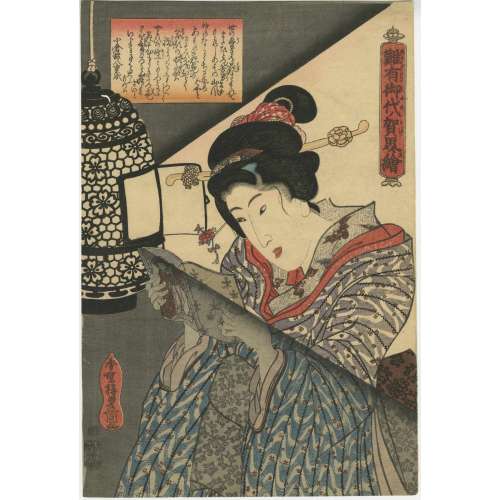 Utagawa Kunisada (Japanese: 歌川 国貞; also known as Utagawa Toyokuni III (三代歌川豊国); 1786 – 12 January 1865).
Utagawa Kunisada (Japanese: 歌川 国貞; also known as Utagawa Toyokuni III (三代歌川豊国); 1786 – 12 January 1865).A young woman reading a book in the light of a lamp. Series: Arigataki miyo no kage-e (Shadow Pictures of an Auspicious Age). There are five known prints, half-length portraits of beauties, in this series, designed by Kunisada in ca. 1844. Another print from the series in this collection: SVJP-0306.2020: A young woman adjusting her hairpins in the light of a paper lantern.
Signed: Kōchōrō Toyokuni ga (香蝶楼豊国画).
Publisher: Maruya Kiyojiro.
Size: Vertical Ōban (37.5 x 25.4 cm). -
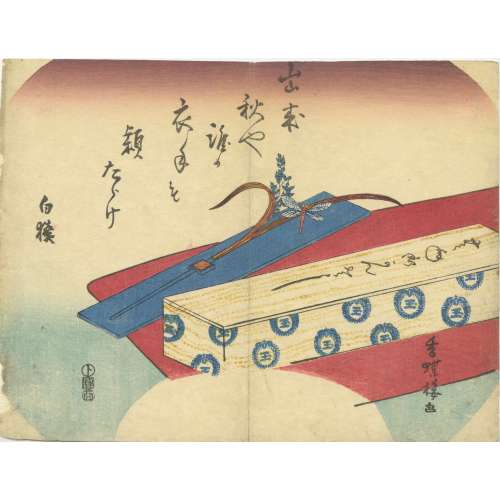 Utagawa Kunisada [歌川 国貞] a.k.a. Utagawa Toyokuni III [三代歌川豊国] (Japanese, 1786 – 1865)
Utagawa Kunisada [歌川 国貞] a.k.a. Utagawa Toyokuni III [三代歌川豊国] (Japanese, 1786 – 1865)Promotional fan for a hairpin shop, with a poem by Ichikawa Danjuro VII, signed Hakuen.
Date seal plus rectangular kiwame seal: Bunsei 8 (1825).
Size: Fan print. Uchiwa-e (27.5 x 21.1 cm) Publisher seal: Maru-To (2) (Marks U204). Date seal plus rectangular kiwame seal: Bunsei 8 (1825). -
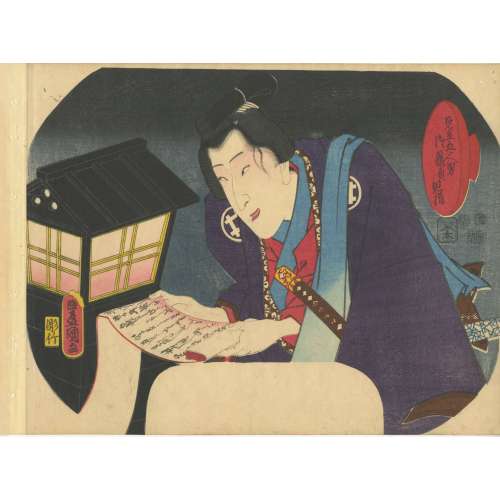 Utagawa Kunisada [歌川 国貞] a.k.a. Utagawa Toyokuni III [三代歌川豊国] (Japanese, 1786 – 1865).
Utagawa Kunisada [歌川 国貞] a.k.a. Utagawa Toyokuni III [三代歌川豊国] (Japanese, 1786 – 1865).Uncut fan print (uchiwa-e), 295 x 230 mm, depicting kabuki actor Bandō Shūka I as Shirai Gonpachi (白井権八) reading a scroll by the light of a lantern. From the series A Parody of the Five Chivalrous Commoners; a Cup of Sake From Their Fans (Mitate gonin otoko, go-hiiki no omoizashi). According to Paul Griffith, the term omoizashi refers to the act of pouring a cup of sake for one's chosen partner, here giving an impression of intimacy and affection between famous actors and their patrons.
Actor: Bandō Shūka I [初代坂東しうか] (Japanese, 1813-1855); other names: Bandō Tamasaburō I, Bandō Mitsugorō V (posthumously). The print was probably published by some unknown Yama-Ta (Marks U421b). Double nanushi censor seals and date seal: Muramatsu and Fuku, Kaei 5, 2nd month (2/1852). As Kabuki Encyclopedia put it: "Gonpachi. A parasite. From the character named Shirai Gonpachi who lives at the home of Banzui Chōbei and sponges off him" (An English-Langauge Adaptation of Kabuki Jiten. Samuel L. Leiter. Greenwood Press, 1979, pp. 26, 98-9). There were many kabuki plays based on the story of the lovers Miura-ya Komurasaki and Shirai Gonpachi. (See: [LIB-2226.2019] Algernon Bertram Freeman-Mitford. Tales of Old Japan. — London: Macmillan and Co., 1883). Ref.: Art shop Ezoshi Ukiyoe new collection news, vol. 66, 2023.1 (Jan) # 31, p.8. -
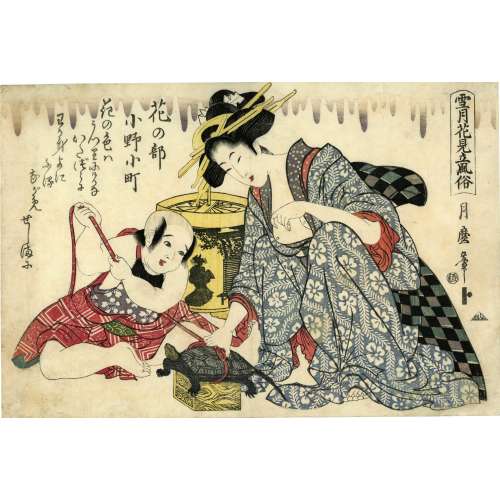
Kitagawa Tsukimaro (Kikumaro): 喜多川 月麿, fl. c. 1794–1836.
Mother is playing with her child: they left playing with shadow lantern for freeing a turtle (Hojo-e, or "Rite for the Release of Living Beings").Signed: Tsukimaro hitsu (月麿筆); Publisher's mark; censor's seal: Kiwame + Yamaguchiya Tôbei gyōji seal (1811-14).
-
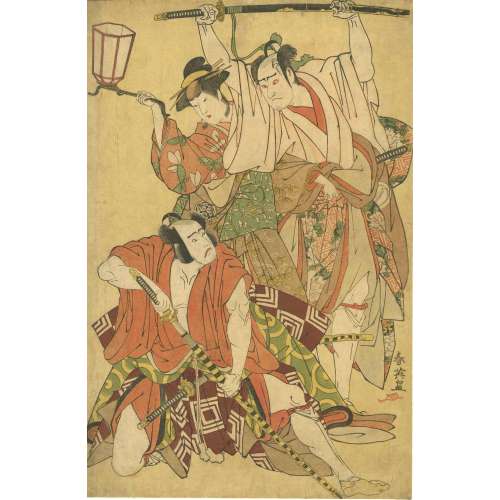 Katsukawa Shun'ei. Signed: Shun'ei ga (春英画). Vertical Ōban. No reference whatsoever. Unidentified play, actors, roles, year, theatre. SOLD
Katsukawa Shun'ei. Signed: Shun'ei ga (春英画). Vertical Ōban. No reference whatsoever. Unidentified play, actors, roles, year, theatre. SOLD -
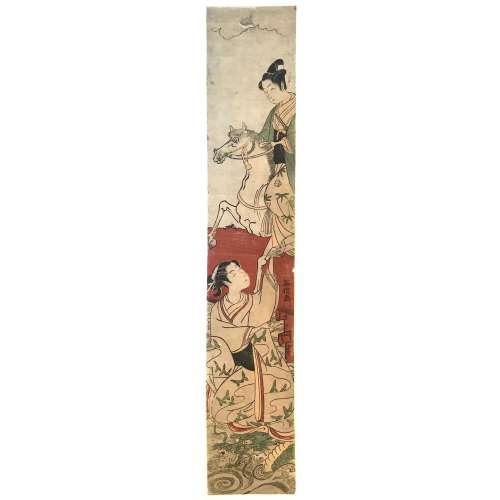 Santō Kyōden (山東 京伝, September 13, 1761 Edo – October 27, 1816) was a Japanese poet, writer and artist in the Edo period. He studied ukiyo-e under master Kitao Shigemasa (北尾 重政) [see SVJP-0006], and began illustrating kibyōshi under the pseudonym of Kitao Masanobu (北尾 政寅).
Santō Kyōden (山東 京伝, September 13, 1761 Edo – October 27, 1816) was a Japanese poet, writer and artist in the Edo period. He studied ukiyo-e under master Kitao Shigemasa (北尾 重政) [see SVJP-0006], and began illustrating kibyōshi under the pseudonym of Kitao Masanobu (北尾 政寅).Signed: Masunobu ga.
"Parody of the Nō Play Chōryō" (elsewhere) or "Parody of Huáng Shigōng and Zhāng Liáng" (David Waterhouse, The Harunobu Decade, Hotei Publishing, 2013, v. 2, №651). "The story [...] is about an encounter between the Chinese government minister Chôryô (Zhāng Liáng) and the legendary elder Kôsekikô (Huáng Shigōng) in the 3rd century BC. While riding a mule across a bridge, Kôsekikô dropped his sandal. Chôryô returned it to him. As a reward, Kôsekikô gave Chôryô a book of military strategy. Later, Chôryô helped to establish the Han Dynasty (207 BC-AD 220)." [The Walters Art Museum]References:
Waterhouse, The Harunobu Decade (2013), #651; Ukiyo-e shûka supp. 2 (1982), pl. 625; Pins, The Japanese Pillar Print (1982), #274/p.145; J. Kurth, Die Geschichte..., vol. II, Leipzig, 1928; S. Kikuchi, Ukiyo-e, 1966.
-
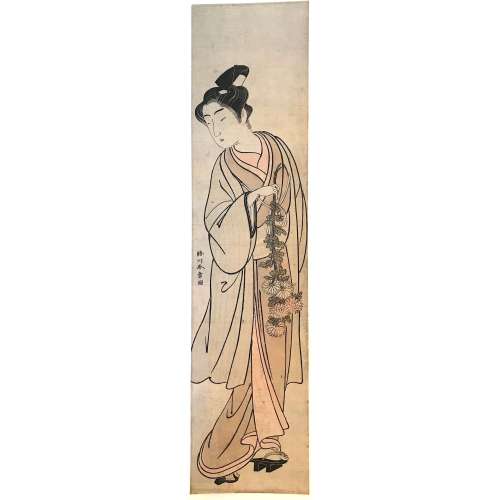 Katsukawa Shunshō ( 勝川 春章; 1726 – 19 January 1793).
Katsukawa Shunshō ( 勝川 春章; 1726 – 19 January 1793).Signed: Katsukawa Shunshô ga (勝川春章画).
The size is somewhat larger than the standard pillar print (hashira-e): 16.3 x 67.7 cm.
No references found so far.
-
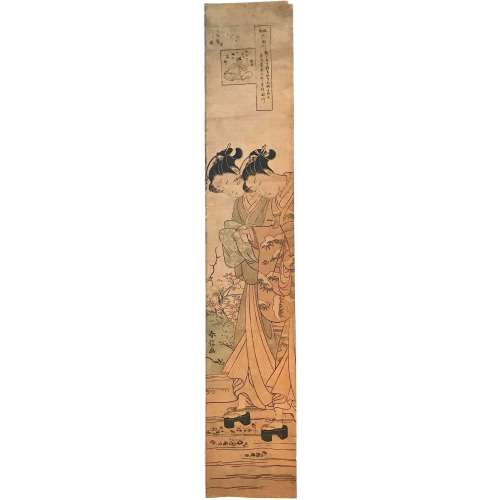 Suzuki Harunobu (鈴木 春信; c. 1725 – 15 July 1770).
Suzuki Harunobu (鈴木 春信; c. 1725 – 15 July 1770).The Ide Jewel River, a Famous Place in Yamashiro Province (Ide no Tamagawa, Yamashiro no meisho), from the series The Six Jewel Rivers in Popular Customs (Fûzoku Mu Tamagawa).
Signed: Harunobu gaInscription - Poem: Koma tomete/ nao mizu kawan/ yamabuki no/ hana no tsuyu sou/ Ide no Tamagawa
References:MFA # 21.4540.
Waterhouse cat. #562; Pins, The Japanese Pillar Print (1982), #139; Ukiyo-e shûka 4 (1979), list #795.4, and supp. 2 (1982), pl. 565; Gentles, AIC cat. II (1965), p. 125, #201.
-
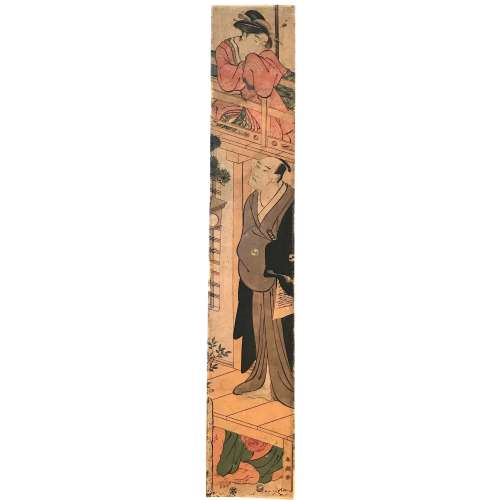 Katsukawa Shunshō ( 勝川 春章; 1726 – 19 January 1793).
Katsukawa Shunshō ( 勝川 春章; 1726 – 19 January 1793).Signed: Shunchô ga (春潮画); Censor's seal: kiwame (改印:極)
Publisher: Iwatoya Kisaburō (Eirindō); c. 1760s – 1832. Marks #173/p.169.
Reference: MFA ACCESSION NUMBER 11.21263. Not in Pins.
Act VII, Gion Ichiriki no ba ("The Ichiriki Teahouse at Gion") This act gives a taste of the bustling atmosphere of the Gion pleasure quarter in Kyoto. Yuranosuke is feigning a life of debauchery at the same teahouse to which Okaru has been indentured. Kudayū, the father of Sadakurō, arrives. He is now working for Moronō and his purpose is to discover whether Yuranosuke still plans revenge or not. He tests Yuranosuke's resolve by offering him food on the anniversary of their lord's death when he should be fasting. Yuranosuke is forced to accept. Yuranosuke's sword – the revered symbol of a samurai – is also found to be covered in rust. It would appear that Yuranosuke has no thoughts of revenge. But still unsure, Kudayū hides under the veranda. Now believing himself alone, Yuranosuke begins to read a secret letter scroll about preparations for the vendetta. On a higher balcony Okaru comes out to cool herself in the evening breeze and, noticing Yuranosuke close by, she also reads the letter reflected in her mirror. As Yuranosuke unrolls the scroll, Kudayū, too, examines the end which trails below the veranda. Suddenly, one of Okaru's hairpins drops to the floor and a shocked Yuranosuke quickly rolls up the scroll. Finding the end of the letter torn off, he realises that yet another person knows his secret and he must silence them both. Feigning merriment, he calls Okaru to come down and offers to buy out her contract. He goes off supposedly to fix the deal. Then Okaru's brother Heiemon enters and, hearing what has just happened, realises that Yuranosuke actually intends to keep her quiet by killing her. He persuades Okaru to let him kill her instead so as to save their honour and she agrees. Overhearing everything, Yuranosuke is now convinced of the pair's loyalty and stops them. He gives Okaru a sword and, guiding her hand, thrusts it through the floorboards to kill Kudayū. The main actor has to convey a wide variety of emotions between a fallen, drunkard rōnin and someone who in reality is quite different since he is only faking his weakness. This is called hara-gei or "belly acting", which means he has to perform from within to change characters. It is technically difficult to perform and takes a long time to learn, but once mastered the audience takes up on the actor's emotion. Emotions are also expressed through the colours of the costumes, a key element in kabuki. Gaudy and strong colours can convey foolish or joyful emotions, whereas severe or muted colours convey seriousness and focus. -
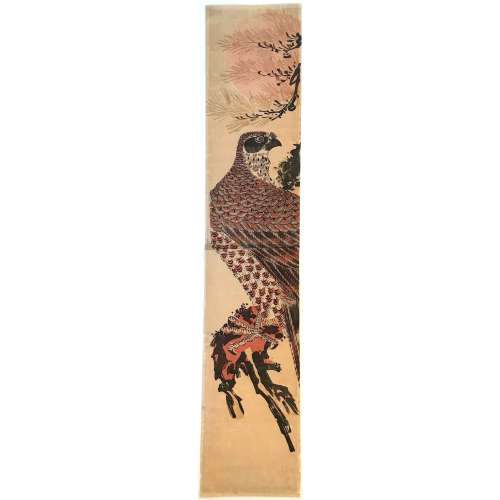 The print lacks signature. It is attributed by some to Suzuki Harunobu and by the others to Isoda Koryūsai.
The print lacks signature. It is attributed by some to Suzuki Harunobu and by the others to Isoda Koryūsai.Attributed to Koryūsai: Pins #517/p.209, c. 1775 [AIC II: Clarence Buckingham Collection, 1925.2772], Ukiyo-e Taisei IV; Vignier & Inada, 1911; Ritsumeikan University Z0165-239.
Attributed to Harunobu: Pins #239/p.132.; BM 1906,1220,0.85;
-
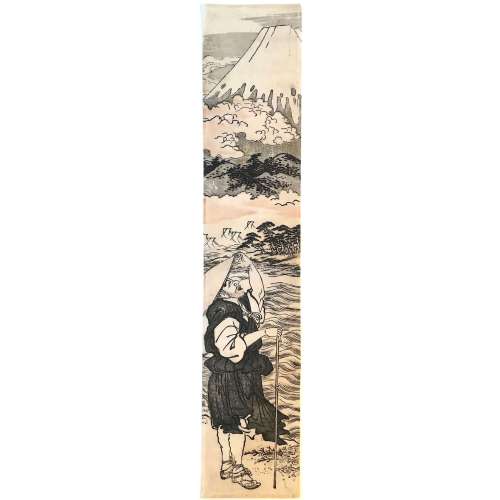 Isoda Koryūsai (礒田 湖龍斎, 1735–1790), flourished: 1769 to 1790. The print lacks signature (signature erased).
Isoda Koryūsai (礒田 湖龍斎, 1735–1790), flourished: 1769 to 1790. The print lacks signature (signature erased).Attributed definitely to Koryūsai: Jacob Pins, #491 [p.202] - Saigyo Hoshi admiring Mount Fuji. Signature erased but convincingly attributed to Koryusai. Tikotin Museum, Haifa. Catalogue raisonné: Allen Hockley: A3-J-5 (p. 261).
Saigyō Hōshi (西行 法師, 1118 – March 23, 1190) was a famous Japanese poet of the late Heian and early Kamakura period. -
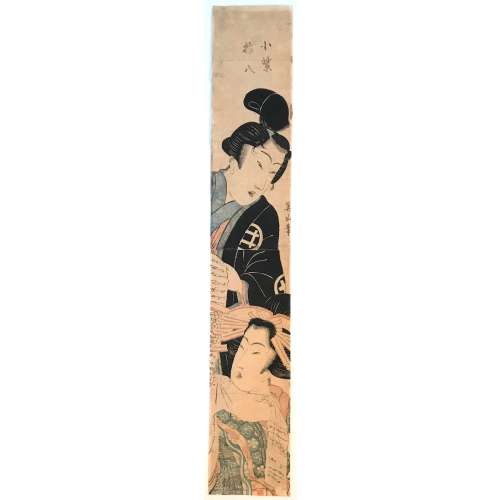 Kikukawa Eizan (菊川 英山, 1787 – July 17, 1867) Signed: Eizan hitsu (英山筆)
Kikukawa Eizan (菊川 英山, 1787 – July 17, 1867) Signed: Eizan hitsu (英山筆)Jacob Pins #972/p.341. Leiden, Rijksmuseum voor Volkenkunde.
"The Lovers Miura-ya Komurasaki and Shirai Gonpachi: Tragic love stories taken from real life and dramatized were a staple of stage and print; the darkly romantic combination of desire and death was hugely popular in the eighteenth century. Hirai Gompachi was a warrior of the Tottori fief in western Japan who fled to Edo after committing a murder. He was apprehended and sentenced to death in 1679. His distraught lover, the courtesan Komurasaki, committed suicide at his grave." [MET]
.
-
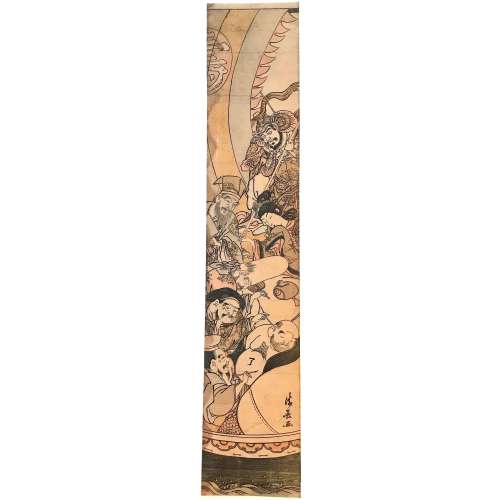 Torii Kiyonaga (鳥居 清長; 1752 – June 28, 1815) Signed: Kiyonaga ga (清長画)
Torii Kiyonaga (鳥居 清長; 1752 – June 28, 1815) Signed: Kiyonaga ga (清長画)References: No references whatsoever, not in Pins.
-
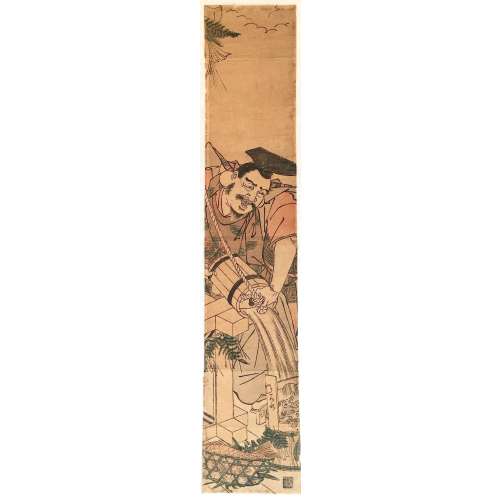 Ebisu drawing wakamizu, the first water drawn from a well on the New Year. Kitao Shigemasa (北尾 重政, 1739 – 8 March 1820). Signed: Shigemasa. Publisher's mark: Nishimuraya Yohachi.
Ebisu drawing wakamizu, the first water drawn from a well on the New Year. Kitao Shigemasa (北尾 重政, 1739 – 8 March 1820). Signed: Shigemasa. Publisher's mark: Nishimuraya Yohachi.References:
Jacob Pins #547 [p.217] - Ebisu drawing wakamizu, the first water drawn from a well on the New Year. TNM II (Tokyo National Museum Catalogue vol. 2) #1373.
-
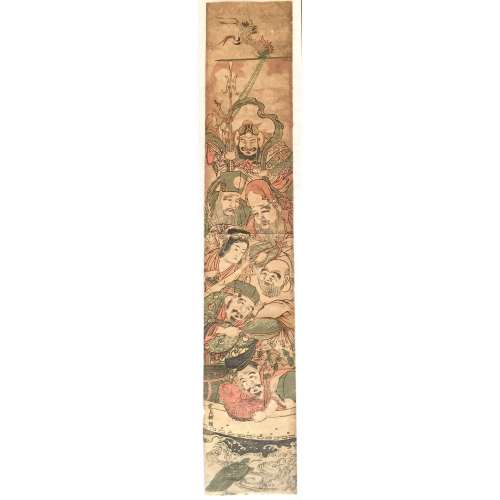 The Seven Gods of Good Luck in the Takarabune (ship of fortune) with a crane (the phoenix) above them.
The Seven Gods of Good Luck in the Takarabune (ship of fortune) with a crane (the phoenix) above them.Attributed to Katsukawa Shunshō, fl. 1726–92. Publisher: Uemura from Shiba (Edo). Marks "Publishers": U361|25-300: Uemura han (1793-1813). Marks "Artists, publishers...": Emiya Kichiemon (1688-1835). Artist signature absent. Looks very much like Pins #565 [p.223], but NOT the same. This exact design has not been found anywhere.
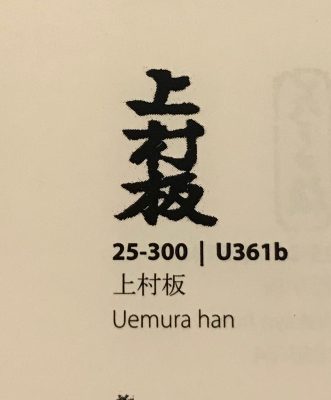
-
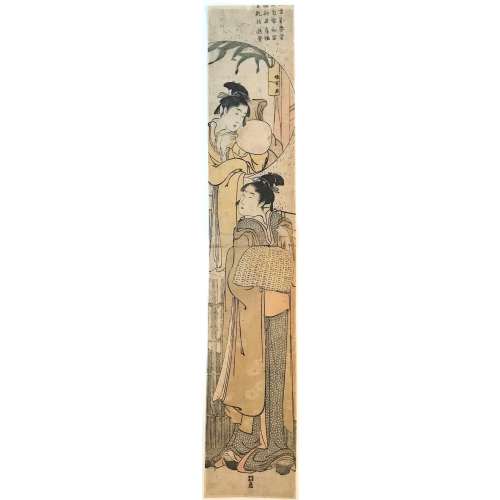 Woman Looking out a Round Window at a Woman with a Komusō Hat.
Woman Looking out a Round Window at a Woman with a Komusō Hat.Artist Koikawa Harumasa (a.k.a. Banki): fl. 1801–18. Wikipedia: Koikawa Harumasa (恋川 春政; active 1800–1820), later called Banki Harumasa (晩器 春政). Associated with Katsukawa school.
Signed: Banki ga (on the bamboo flower container in the background). Censor's seal: kiwame. Mark of unidentified publisher, Genshoku #1017; Marks U084 Ibiko, p. 387.
References:
Jacob Pins #828.
-
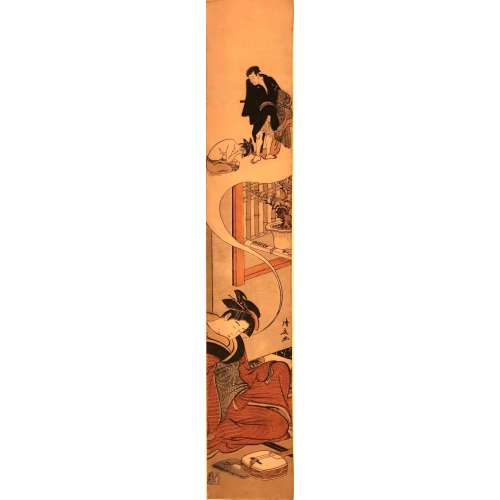 Torii Kiyonaga (1752-1815) Color woodblock print: hashira-e, 68.9 x 12.1 cm. DATE: 1783. Signed: Kiyonaga ga Publisher: Eijudō (Nishimuraya Yohachi) "Young musician dreams of being abducted by a ruffian. Long hours on duty have exhausted this young musician who sits sleeping with her shamisen and book placed on the ground in front of her. In her dream, she is being abducted by a ruffian who has stripped her of her clothing" [LIB-1474.2018: Important Japanese prints from the collection of Henry Steiner. Catalogue № 14. — NY: Sebastian Izzard LLC, 2018.]
Torii Kiyonaga (1752-1815) Color woodblock print: hashira-e, 68.9 x 12.1 cm. DATE: 1783. Signed: Kiyonaga ga Publisher: Eijudō (Nishimuraya Yohachi) "Young musician dreams of being abducted by a ruffian. Long hours on duty have exhausted this young musician who sits sleeping with her shamisen and book placed on the ground in front of her. In her dream, she is being abducted by a ruffian who has stripped her of her clothing" [LIB-1474.2018: Important Japanese prints from the collection of Henry Steiner. Catalogue № 14. — NY: Sebastian Izzard LLC, 2018.]The Japanese Pillar Print. Hashira-e. Jacob Pins. Foreword by Roger Keyes. Robert G. Sawers Publishing, London, 1982 [LIB-1543.2018 in this collection] -> page 262 №703: A young woman dreaming of rape and robbery. 1783. Hirano.
MFA: ACCESSION NUMBER 21.5546: Young Woman Music Teacher Dreaming of a Robbery [追剥の夢を見る三味線師匠]. Edo period, about 1783 (Tenmei 3). Artist Torii Kiyonaga (1752–1815), Publisher Nishimuraya Yohachi (Eijudô). Harvard Museums Object Number 1916.586: Female Musician Dreaming of Robbery. Edo period, circa 1783. Torii Kiyonaga, Japanese (1752 - 1815) . Published by Nishimuraya Yohachi. -
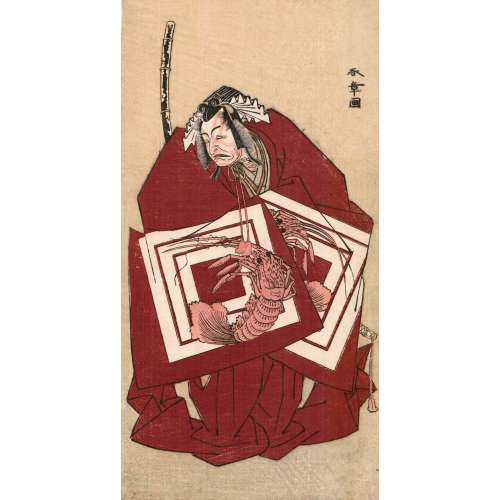 Ichikawa Ebizō III (Matsumoto Kōshirō II, Ichikawa Danjūrō IV, 1711-1778) probably shown as Shinozuka Gorō in the Shibaraku scene of the play Ōyoroi Ebidō Shinozuka, performed at the Nakamura Theater in the 11th month of 1772 (Meiwa 9). This was the occasion when he celebrated his name change, from Matsumoto Kōshirō II to Ichikawa Ebizō III. The lobster or giant shrimp (ebi) upon the Ichikawa family crest (three concentric squares - three measures of rice) on his garment underscores the fact of the name change (ebizō).
Ichikawa Ebizō III (Matsumoto Kōshirō II, Ichikawa Danjūrō IV, 1711-1778) probably shown as Shinozuka Gorō in the Shibaraku scene of the play Ōyoroi Ebidō Shinozuka, performed at the Nakamura Theater in the 11th month of 1772 (Meiwa 9). This was the occasion when he celebrated his name change, from Matsumoto Kōshirō II to Ichikawa Ebizō III. The lobster or giant shrimp (ebi) upon the Ichikawa family crest (three concentric squares - three measures of rice) on his garment underscores the fact of the name change (ebizō). -
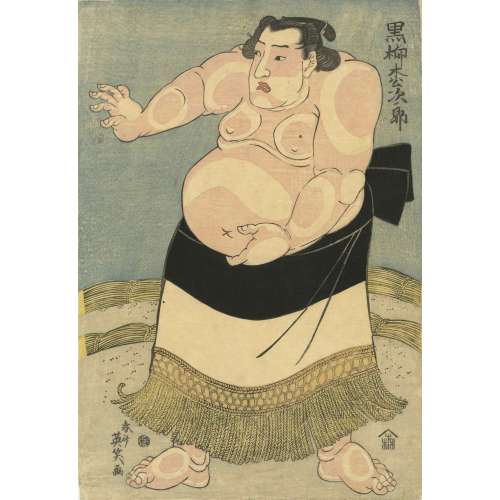 This print was sold to me with the following description: "Ikkansai EISHO (Fl. early 19th c.). A portrait of the wrestler Kuroyanagi Matsujiro, ring name Kumagatake Inosuke. Eisho was a pupil of Eishi. Published c. 1820s by Uoya Eikichi. Signed Shunsai Eisho ga." As a result of our joint effort with my beloved sister, we have so far found the following: The artis is mentioned in The Hotei Encyclopedia of Japanese Woodblock Prints, 2005, Vol 2; p. 438 under the name of Harukawa Eichō. From this source we learned that the artist was active from about 1818 till 1844, and was a print designer in Kyoto. He was a student first of Harukawa Goshichi and later studied in Edo (Tokyo) with Keisai Eisen, when he assumed the art name 'Eichō'. Other names: Shunsai. The Japanese web page dedicated to Harukawa Eichō provides more details: The artist lived from the 4th year of Tenmei ( 1784 ) to the first year of Kaei ( 1848 ). He was a student of Harukawa Goshichi, Kikukawa Eizan as well as of Keisai Eisen. His popular name was Kamenosuke. He was from Kyoto. He took "gagō" (artistic names) of Eishō when he was a student of Harukawa Goshichi; later, when he became a student of Kikukawa Eizan and Keisai Eisen he took the name of Kikukawa Eichō. The artist was mostly known for his bijinga (beautiful women) prints as well as kanazōshi illustrations. Nothing is said anywhere about his sumo prints, though the reference to another Kyushu sumo wrestler portrait has been found. The sumo wrestler Kuroyanagi Matsujiro is also a somewhat obscure figure: information about his life and career is quite inconsistent. It may so happened that two different persons were combined together. Wikipedia page about Aoi Aso Jinja, a Shinto shrine in Hitoyoshi in Kumamoto prefecture, tells us the following:This information has some inconsistencies already. If our hero was born in 1807 and promoted to ōzeki at the age of 32, it should have been the year 1839, not 1847. I found Kumagatake Isuke at "Sumo Reference" website:
This print was sold to me with the following description: "Ikkansai EISHO (Fl. early 19th c.). A portrait of the wrestler Kuroyanagi Matsujiro, ring name Kumagatake Inosuke. Eisho was a pupil of Eishi. Published c. 1820s by Uoya Eikichi. Signed Shunsai Eisho ga." As a result of our joint effort with my beloved sister, we have so far found the following: The artis is mentioned in The Hotei Encyclopedia of Japanese Woodblock Prints, 2005, Vol 2; p. 438 under the name of Harukawa Eichō. From this source we learned that the artist was active from about 1818 till 1844, and was a print designer in Kyoto. He was a student first of Harukawa Goshichi and later studied in Edo (Tokyo) with Keisai Eisen, when he assumed the art name 'Eichō'. Other names: Shunsai. The Japanese web page dedicated to Harukawa Eichō provides more details: The artist lived from the 4th year of Tenmei ( 1784 ) to the first year of Kaei ( 1848 ). He was a student of Harukawa Goshichi, Kikukawa Eizan as well as of Keisai Eisen. His popular name was Kamenosuke. He was from Kyoto. He took "gagō" (artistic names) of Eishō when he was a student of Harukawa Goshichi; later, when he became a student of Kikukawa Eizan and Keisai Eisen he took the name of Kikukawa Eichō. The artist was mostly known for his bijinga (beautiful women) prints as well as kanazōshi illustrations. Nothing is said anywhere about his sumo prints, though the reference to another Kyushu sumo wrestler portrait has been found. The sumo wrestler Kuroyanagi Matsujiro is also a somewhat obscure figure: information about his life and career is quite inconsistent. It may so happened that two different persons were combined together. Wikipedia page about Aoi Aso Jinja, a Shinto shrine in Hitoyoshi in Kumamoto prefecture, tells us the following:This information has some inconsistencies already. If our hero was born in 1807 and promoted to ōzeki at the age of 32, it should have been the year 1839, not 1847. I found Kumagatake Isuke at "Sumo Reference" website:Kuroki Matsujiro (黒木松次郎) was born in the village of Itsuki in Kuma district, Kumamoto prefecture, island of Kyushu in Bunka era, 4th year (1807). Since from his childhood he was blessed by great physique and tough strength. He had affection for sumo. At the age of 18 he became a sumo student of Kumamoto Shimakawa Ikuhei and took the name of Toyama Hidekichi (遠山日出吉). At the age of 23 (1830), he entered sumo stables in Kyoto, mastered the art of taming of young horses, and his talents improved. At the age of 31 he went to Edo, and became a disciple of the ōzeki Oitekaze Kitaro of Hirado domain in Hizen province, also from Kyushu island. After that, he changed his name and became Kuroyanagi Matsujiro (黒柳松次郎 – as on the print). In 1847 (Bunka era, 4th year) he distinguished himself by advancing to the first grade, and at the age of 32 he was promoted to ozeki level, becoming sekitori. After changing his name to Kuma-ga-take Inosuke (熊ヶ嶽猪之介 / くまがたけいのすけ) he displayed further efforts, and became one of the strongmen that fermented sumo wrestling in Edo. In 1853 (Kaei era, 6th year) he retired and returned to his village, becoming an employee as a strongman of Sagara domain (相良藩), and worked hard as instructor of the sumo training hall to train successors until 1855 (Ansei era, 2nd year) when he passed away at the age of 48. Even today Kuma-ga-take's home exists in Itsukimura (his native village). Also, on those grounds a descendant of Kuma-ga-take runs minshuku (guest house) that bears the name of "The Kuroki Pension (lodging) ", and tourists come to visit from various parts of Japan. In 2015, tenth month, within the borders of Aoi Aso Shrine there was built a gravestone publicly honoring Kuma-ga-take Inosuke, sumo wrestler from Edo / of Edo period.
The real name is the same, the ring name Kuroyanagi Matsujiro is the same, however, the date of birth here is 1815. He fought from 1836 till 1853 - which is quite similar to "At the age of 31 he went to Edo, and became a disciple of the ōzeki Oitekaze Kitaro". Though, in 1836 he might be 29 years old. His bouts are listed from spring 1841 to spring 1848 under the name of Kuroyanagi and from winter 1848 till spring 1853 he listed under the name of Kumagatake Isuke [Inosuke].Highest Rank Maegashira 4 Real Name Kuroki Birth Date 1815 Shusshin Kumamoto-ken, Kuma-gun Death Date March 6, 1855 (40 years) Heya Oitekaze Shikona Kuroyanagi Matsujiro - Kumagatake Isuke Hatsu Dohyo 1836.02 (Sandanme) Intai 1853.02 On another important sumo history website, I found that Kuroyanagi first appeared at ring in the spring of 1823 (he might have been 16 years old then, which does not seem right). Then, in the winter tournament of 1848 Kuroyanagi took the name Kumagatake. At the spring tournament of 1853 Kumagatake (Kuroyanagi) retired. This is quite consistent so far.
Then, I found Oitekaze Kitaro, allegedly the teacher of Kuroyanagi.
Everything look good with an exception of ring names (shikona): Kuroyanagi Matsujiro (1823-1828) - Kuroyanagi Sumiemon (1829-30) - Oitekaze Kitaro (1831-1839). May it be that Sato Matsutaro fought under the name of Kuroyanagi Matsujiro until Kuroki Matsujiro took this name from his master? I don't have another explanation of the enigma. What we know is that we have a portrait of a sumo wrestler called Kuroyanagi Matsujiro from Kyushu, but we don't know whether this was the one from Kumamoto (Kumagatake Inosuke, 1807/1815-1855) or the other from Kanagawa (Oitekaze Kitaro, 1799-1865). Subsequently, we may declare that the artist is Shunsai Eishō, a.k.a.Harukawa Eichō from Eishi school (The Hotei Encyclodepdia, p. 524), we can date the print from 1818 to 1844, and only tell that the wrestler is Kuroyanagi Matsujiro from Kyushu (either Kumagatake Inosuke or Oitekaze Kitaro). The publisher of the print is Moriya Jihei (Marks №353, p. 243-5). That's it.Highest Rank Ozeki Real Name SATO Matsujiro (Matsutaro#) Birth Date 1799 Shusshin Kanagawa-ken, Tsukui-gun Death Date May 4, 1865 (66 years) Heya Oitekaze Shikona Kuroyanagi Matsujiro - Kuroyanagi Sumiemon - Oitekaze Kitaro Hatsu Dohyo 1817.10 (Jonokuchi) Intai 1839.03 -
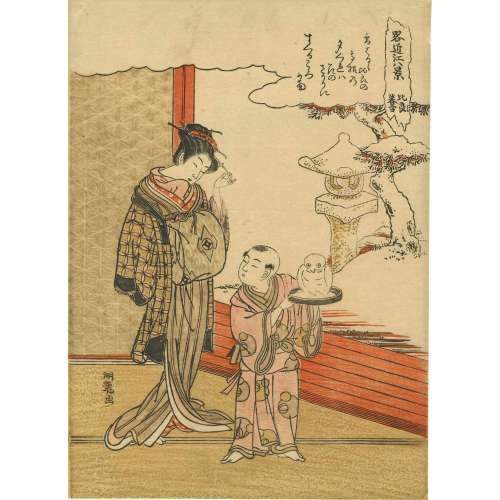 Evening Snow on Mount Hira (Hira no bosetsu), from the series Eight Views of Ōmi in Modern Guise (Ryaku Ōmi hakkei, (略近江八景). About 1773–75 (An'ei 2–4). Artist: Isoda Koryūsai (Japanese, 1735–1790) CATALOGUE RAISONNÉ: Hockley 2003, p. 202, #F-21-1 DIMENSIONS: Vertical chûban; 26 x 19.3 cm (10 1/4 x 7 5/8 in.)Signed: Koryû ga [湖竜画]
Evening Snow on Mount Hira (Hira no bosetsu), from the series Eight Views of Ōmi in Modern Guise (Ryaku Ōmi hakkei, (略近江八景). About 1773–75 (An'ei 2–4). Artist: Isoda Koryūsai (Japanese, 1735–1790) CATALOGUE RAISONNÉ: Hockley 2003, p. 202, #F-21-1 DIMENSIONS: Vertical chûban; 26 x 19.3 cm (10 1/4 x 7 5/8 in.)Signed: Koryû ga [湖竜画] -
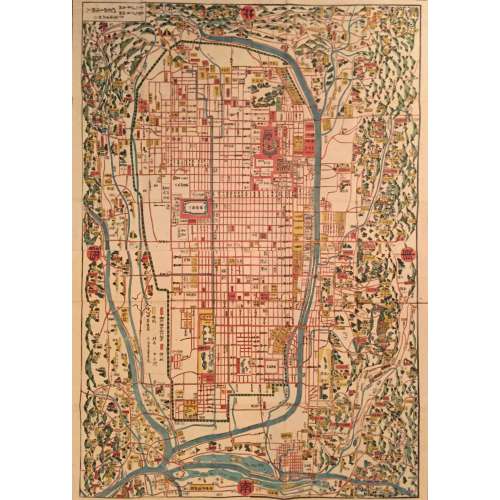
-
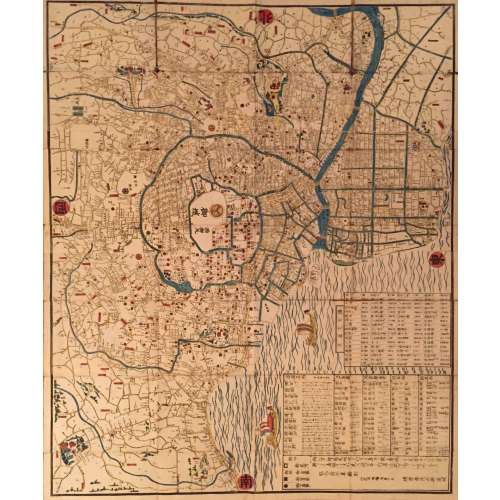
-
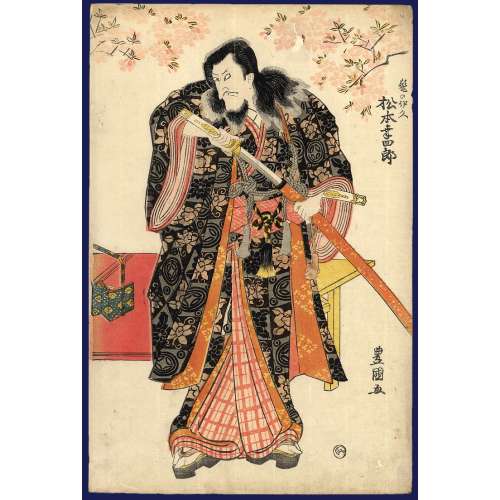 Artist: Utagawa Toyokuni I (1769–1825) Actor Matsumoto Kōshirō V plays the role of Ikyû in the drama "Sukeroku Yukari no Edo Zakura". The roles of Sukeroku and the courtesan Agemaki are played by Ichikawa Danjûrô VII and Iwai Hanshirô V". Ichimura Theater in Edo in 2nd lunar month of 1811. Publisher: Chōjiya Kichi (1811-1826); Marks' "Publishers" № 028, p. 103. Size: Vertical ôban Woodblock print (nishiki-e); ink and color on paper. Signed: Toyokuni ga My print is the right sheet of a triptych (see: Rare books exhibition in January 2013).
Artist: Utagawa Toyokuni I (1769–1825) Actor Matsumoto Kōshirō V plays the role of Ikyû in the drama "Sukeroku Yukari no Edo Zakura". The roles of Sukeroku and the courtesan Agemaki are played by Ichikawa Danjûrô VII and Iwai Hanshirô V". Ichimura Theater in Edo in 2nd lunar month of 1811. Publisher: Chōjiya Kichi (1811-1826); Marks' "Publishers" № 028, p. 103. Size: Vertical ôban Woodblock print (nishiki-e); ink and color on paper. Signed: Toyokuni ga My print is the right sheet of a triptych (see: Rare books exhibition in January 2013). A lookalike triptych by Kunisada can be found in Ronin Gallery:
A lookalike triptych by Kunisada can be found in Ronin Gallery:
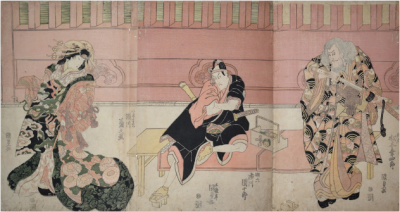 Data from Kabuki21:
Stage names:
Matsumoto Kôshirô V, Ichikawa Komazô III, Ichikawa Sumizô I
Guild: Kôraiya
Line number: GODAIME (V)
Poetry names: Kinshô, Kinkô
Existence: 1764 ~ 10th day of the 5th lunar month of 1838
Connection:
Father: Matsumoto Kôshirô IV
Sons: Matsumoto Kôshirô VI, Ichikawa Sumizô II
Disciples: Matsumoto Kojirô, Matsumoto Kingo I, Matsumoto Hidejûrô II
Data from Kabuki21:
Stage names:
Matsumoto Kôshirô V, Ichikawa Komazô III, Ichikawa Sumizô I
Guild: Kôraiya
Line number: GODAIME (V)
Poetry names: Kinshô, Kinkô
Existence: 1764 ~ 10th day of the 5th lunar month of 1838
Connection:
Father: Matsumoto Kôshirô IV
Sons: Matsumoto Kôshirô VI, Ichikawa Sumizô II
Disciples: Matsumoto Kojirô, Matsumoto Kingo I, Matsumoto Hidejûrô II
Matsumoto Kôshirô V was one of the Kabuki giants, a senryô yakusha, during the Bunka, Bunsei and Tenpô eras. In his 20's he was a tachiyaku actor excelling in nimaime roles like Soga Jûrô Sukenari in sogamono dramas. He started to perform jitsuaku roles from the 11th lunar month of 1798 and quickly became one of the best actors for villain roles, especially in Tsuruya Nanboku IV's kizewamono. He had a considerable influence on actors like Onoe Kikugorô III or Ichikawa Danjûrô VII. The kata he deviced for some of the most famous roles in Kabuki history, like Gonta ("Sushiya") or Nikki Danjô* ("Meiboku Sendai Hagi") are still used nowadays. "The fifth Kôshirô had a very large nose and his eyes were close together, two facial defects the print artists were fond of depicting, so that this Edo actor is easily picked out in the pictures illustrating the theatre of this time." (Zoë Kincaid in "Kabuki, the Popular Stage of Japan")
-
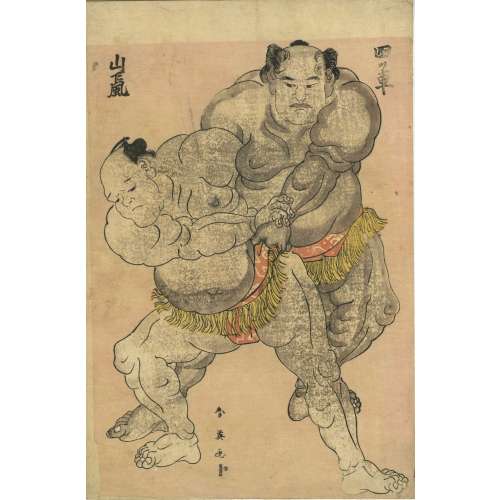 Katsukawa Shun'ei. The Sumo Bout between Yotsuguruma (right) and Yamaoroshi (left). Date: 1800 or 1805/06. Similar sheet can be found at Edo Tokyo Museum. Size: Vertical Ōban. Sumo wrestler Yotsuguruma Daihachi (1772 - 1809) first appeared in the records of national tournaments in winter of 1794. Then he lost 3 matches and won zero. He first won in the spring tournament of 1797 in a match against maegashira (the fifth-highest rank of sumo wrestlers) named Kougamine. Yamaoroshi Gengo (born 1762) came in at the winter tournament of 1799 . He was much more successful in his career than Yotsuguruma, but he had never won a tournament. It was the time of great Raiden, who won most of them. In the spring tournament of 1800 Yotsuguruma and Yamaoroshi fought against each other for the first time. Yotsuguruma lost. The next time they met on the ring was at the winter tournament of 1805, and again in 1806. Both matches were won by Yamaoroshi. Yamaoroshi retired in 1809; Yotsuguruma died in 1809.
Katsukawa Shun'ei. The Sumo Bout between Yotsuguruma (right) and Yamaoroshi (left). Date: 1800 or 1805/06. Similar sheet can be found at Edo Tokyo Museum. Size: Vertical Ōban. Sumo wrestler Yotsuguruma Daihachi (1772 - 1809) first appeared in the records of national tournaments in winter of 1794. Then he lost 3 matches and won zero. He first won in the spring tournament of 1797 in a match against maegashira (the fifth-highest rank of sumo wrestlers) named Kougamine. Yamaoroshi Gengo (born 1762) came in at the winter tournament of 1799 . He was much more successful in his career than Yotsuguruma, but he had never won a tournament. It was the time of great Raiden, who won most of them. In the spring tournament of 1800 Yotsuguruma and Yamaoroshi fought against each other for the first time. Yotsuguruma lost. The next time they met on the ring was at the winter tournament of 1805, and again in 1806. Both matches were won by Yamaoroshi. Yamaoroshi retired in 1809; Yotsuguruma died in 1809. -
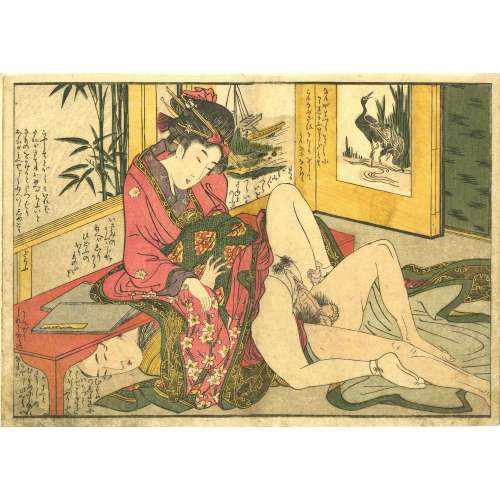 Kitagawa Utamaro. Illustration from book Ehon koi no Onamaki, published in 1799. Reference found by Chris Uhlenbeck: he found one of the designs in Hayashi Yoshikazu's 20-volume set Edo makura-e shi shusei: Kitagawa Utamaro. Size: Chuban (25.5 x 18.5 cm), two book pages glued together.
Kitagawa Utamaro. Illustration from book Ehon koi no Onamaki, published in 1799. Reference found by Chris Uhlenbeck: he found one of the designs in Hayashi Yoshikazu's 20-volume set Edo makura-e shi shusei: Kitagawa Utamaro. Size: Chuban (25.5 x 18.5 cm), two book pages glued together. -
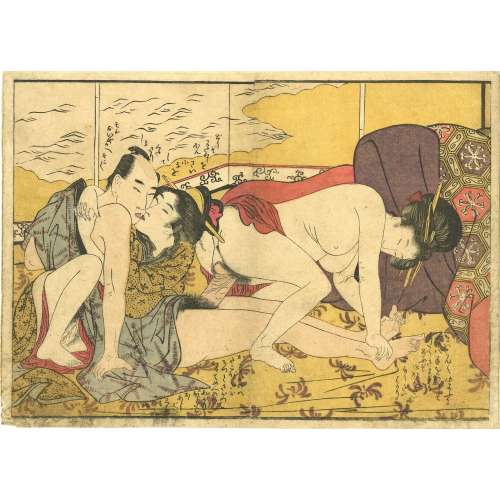 Kitagawa Utamaro. Illustration from the book Ehon koi no Onamaki. Cited at Hayashi Yoshikazu's 20-volume set Edo makura-e shi shusei: Kitagawa Utamaro. Size: Chuban (25.5 x 18.5 cm), two book pages glued together.
Kitagawa Utamaro. Illustration from the book Ehon koi no Onamaki. Cited at Hayashi Yoshikazu's 20-volume set Edo makura-e shi shusei: Kitagawa Utamaro. Size: Chuban (25.5 x 18.5 cm), two book pages glued together. -
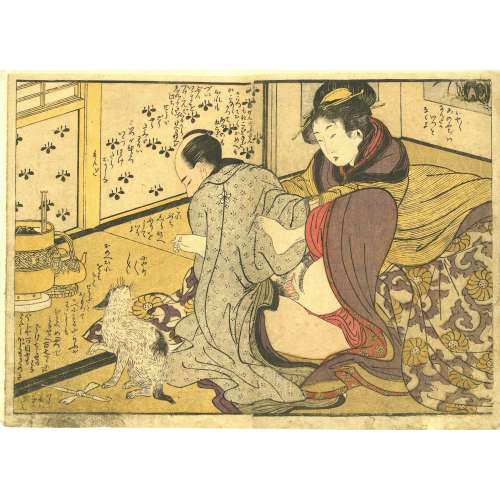 Kitagawa Utamaro. According to Chris Uhlenberg this is an illustration from the book Ehon koi no Onamaki, 3 vols, published in Kansei 11 (1799). Illustrated in b/w in: Hayashi Yoshikazu: Kitagawa Utamaro, in the series: Edo makura-e shi shusei, published in 1990, reissued 1994. Size: Chuban (25.5 x 18.5 cm), two book pages glued together.
Kitagawa Utamaro. According to Chris Uhlenberg this is an illustration from the book Ehon koi no Onamaki, 3 vols, published in Kansei 11 (1799). Illustrated in b/w in: Hayashi Yoshikazu: Kitagawa Utamaro, in the series: Edo makura-e shi shusei, published in 1990, reissued 1994. Size: Chuban (25.5 x 18.5 cm), two book pages glued together. -
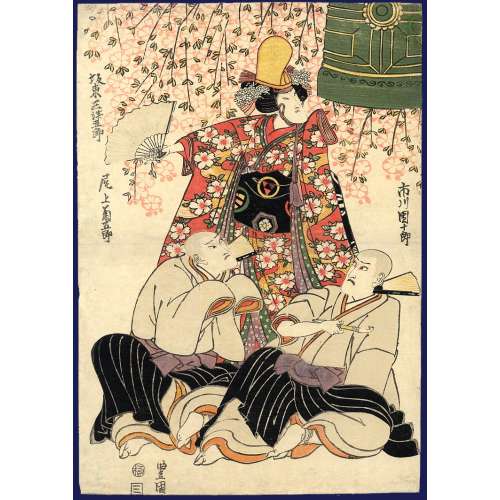 Artist: Utagawa Toyokuni I (1769–1825) Title: Actors Bando Mitsugorō, Ichikawa Danjūrō, Onoe Kikugorō in play The Maiden at Dōjō Temple. Presumably Bunka 13 (1816) at Nakamura Theater in Edo. Publisher: Mikawaya Seiemon (c. 1805-1829); Marks' "Publishers" № 328, p. 235. Size: Vertical ôban MEDIUM OR TECHNIQUE: Woodblock print (nishiki-e); ink and color on paper. Signed: Toyokuni ga Censor's seal: kiwame Detailed discussion on the topic can be seen at: The Maiden at Dōjō Temple
Artist: Utagawa Toyokuni I (1769–1825) Title: Actors Bando Mitsugorō, Ichikawa Danjūrō, Onoe Kikugorō in play The Maiden at Dōjō Temple. Presumably Bunka 13 (1816) at Nakamura Theater in Edo. Publisher: Mikawaya Seiemon (c. 1805-1829); Marks' "Publishers" № 328, p. 235. Size: Vertical ôban MEDIUM OR TECHNIQUE: Woodblock print (nishiki-e); ink and color on paper. Signed: Toyokuni ga Censor's seal: kiwame Detailed discussion on the topic can be seen at: The Maiden at Dōjō Temple -
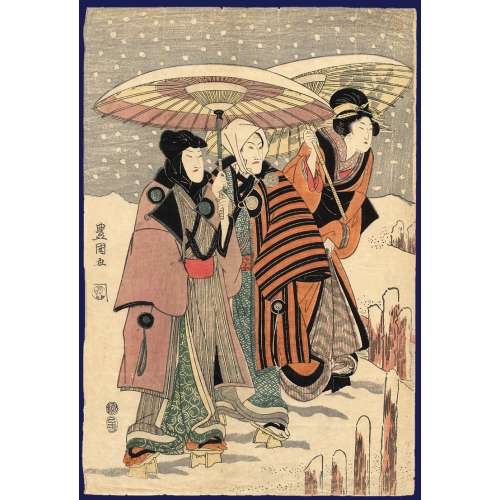 Similar image at MFA under title: Actors and Women in the Snow MFA ACCESSION NUMBER: 11.13568 Date: 1809 (Bunka 6), 12th month Artist: Utagawa Toyokuni I (1769–1825) Publisher Tsuruya Kinsuke (firm name Sôkakudô), № 554 in Marks's "Publishers". DIMENSIONS: Vertical ôban; 38.2 x 25.8 cm (15 1/16 x 10 3/16 in.) MEDIUM OR TECHNIQUE: Woodblock print (nishiki-e); ink and color on paper. Signed: Toyokuni ga (豊国画) Censor's seals: kiwame (改印:極) MFA assumes that this may be "one sheet of incomplete triptych?"
Similar image at MFA under title: Actors and Women in the Snow MFA ACCESSION NUMBER: 11.13568 Date: 1809 (Bunka 6), 12th month Artist: Utagawa Toyokuni I (1769–1825) Publisher Tsuruya Kinsuke (firm name Sôkakudô), № 554 in Marks's "Publishers". DIMENSIONS: Vertical ôban; 38.2 x 25.8 cm (15 1/16 x 10 3/16 in.) MEDIUM OR TECHNIQUE: Woodblock print (nishiki-e); ink and color on paper. Signed: Toyokuni ga (豊国画) Censor's seals: kiwame (改印:極) MFA assumes that this may be "one sheet of incomplete triptych?" -
 Print by Katsukawa Shun'ei that presumably depicts a kabuki actor Ichikawa Monnosuke II. I was not able to find any reference of the image. Size: Hosoban. SOLD
Print by Katsukawa Shun'ei that presumably depicts a kabuki actor Ichikawa Monnosuke II. I was not able to find any reference of the image. Size: Hosoban. SOLD -
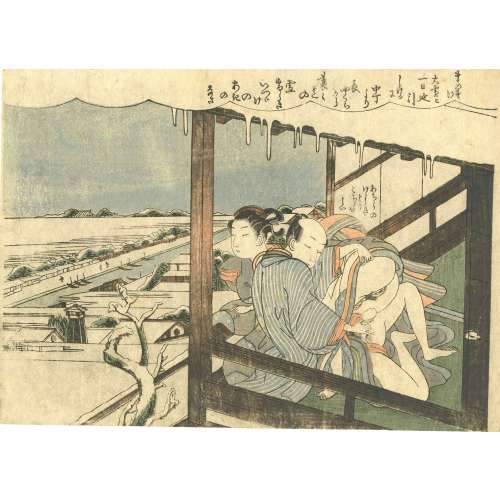 Unsigned print, attributed to Suzuki Harunobu. Erotic scene on open veranda with a winter landscape on background.
Unsigned print, attributed to Suzuki Harunobu. Erotic scene on open veranda with a winter landscape on background. -
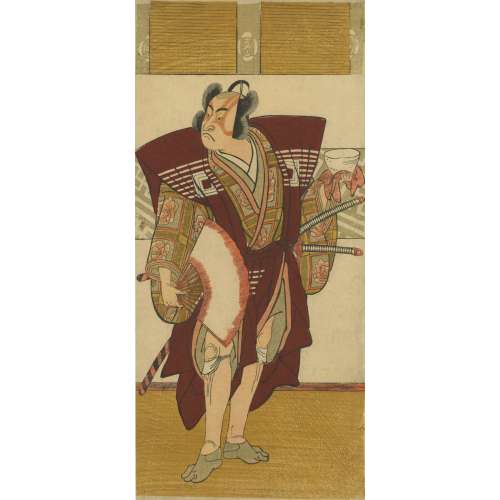 An unsigned print, presumably by Katsukawa Shunshō that presumably depicts a kabuki actor Ichikawa Monnosuke II. I was not able to find any reference of the image. Size: Hosoban. According to The actor's image. Print makers of the Katsukawa School. Timothy T. Clark and Osamu Ueda with Donald Jenkins. Naomi Noble Richard, editor The Art Institute of Chicago in association with Princeton University Press, 1994, Ichikawa Monnosuke II was born in 1743, in Ōji Takinogawa, Edo. He died on October 19, 1974. His specialities were young male roles (wakashu) and male leads (tachi yaku). He was considered to be one of the four best young actors of his day.
An unsigned print, presumably by Katsukawa Shunshō that presumably depicts a kabuki actor Ichikawa Monnosuke II. I was not able to find any reference of the image. Size: Hosoban. According to The actor's image. Print makers of the Katsukawa School. Timothy T. Clark and Osamu Ueda with Donald Jenkins. Naomi Noble Richard, editor The Art Institute of Chicago in association with Princeton University Press, 1994, Ichikawa Monnosuke II was born in 1743, in Ōji Takinogawa, Edo. He died on October 19, 1974. His specialities were young male roles (wakashu) and male leads (tachi yaku). He was considered to be one of the four best young actors of his day. -
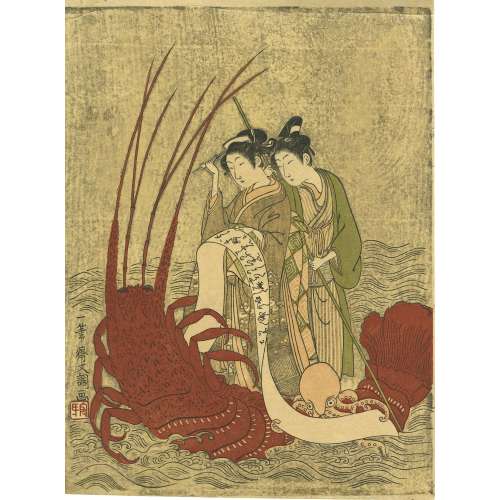 Ippitsusai Bunchō (一筆斎文調); lived 1725-1794; flourished 1755–1790. Size: Chuban; 26 x 20 cm The design presents a young woman reading a scroll while arranging her hear, and a young man with a rowing rod watching over her shoulder; the pair is standing on a giant shrimp that ferries them over a stream. The third passenger is a literate octopus, who's is attentively exploring the text of a scroll. This allusion comes to mind promptly: “Bodhidharma crossing the Yangzi River on a reed” (Royō Daruma).
Ippitsusai Bunchō (一筆斎文調); lived 1725-1794; flourished 1755–1790. Size: Chuban; 26 x 20 cm The design presents a young woman reading a scroll while arranging her hear, and a young man with a rowing rod watching over her shoulder; the pair is standing on a giant shrimp that ferries them over a stream. The third passenger is a literate octopus, who's is attentively exploring the text of a scroll. This allusion comes to mind promptly: “Bodhidharma crossing the Yangzi River on a reed” (Royō Daruma).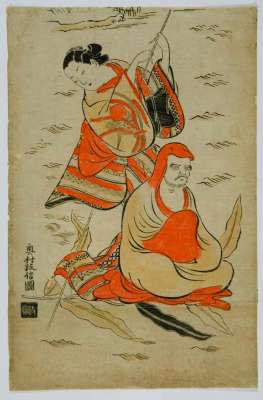 Image from Asian Art Museum in San Francisco:
Image from Asian Art Museum in San Francisco:
Masanobu’s mitate wittily evokes an episode known as “Bodhidharma crossing the Yangzi River on a reed” (Royō Daruma). According to legend, the river crossing occurred en route to the Shaolin monastery, where Bodhidharma sat facing a wall for nine years without speaking. While serious interpretations abound in Chinese and Japanese paintings, popular prints of the Edo period often playfully substituted a beautiful woman for the monk. This parodic version was reportedly invented in response to a courtesan’s comment that she was more enlightened than Bodhidharma because she had spent ten years sitting, on display in a brothel.
An interesting article about this particular design is published at UKIYO-E.ORG BLOG. Though, the design is erroneously attributed to Harunobu. We see that Bunchō was quite fascinated by the idea of crossing a water obstacle with the help of an unsuitable means of transportation: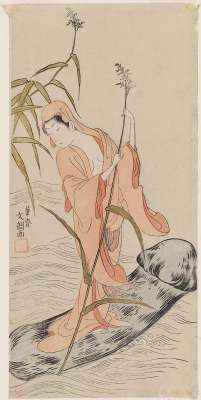
Female Daruma Riding a Mushroom. MFA # 21.4758.
-
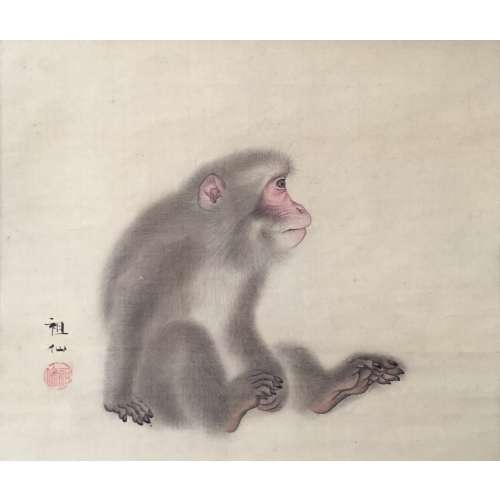 Mori Sosen (1747-1821). Seated Monkey. Hanging scroll painting. Ink and colour on silk. Signed: Sosen. Sealed: Sosen. 28.8 x 33.3 cm.
Mori Sosen (1747-1821). Seated Monkey. Hanging scroll painting. Ink and colour on silk. Signed: Sosen. Sealed: Sosen. 28.8 x 33.3 cm. -
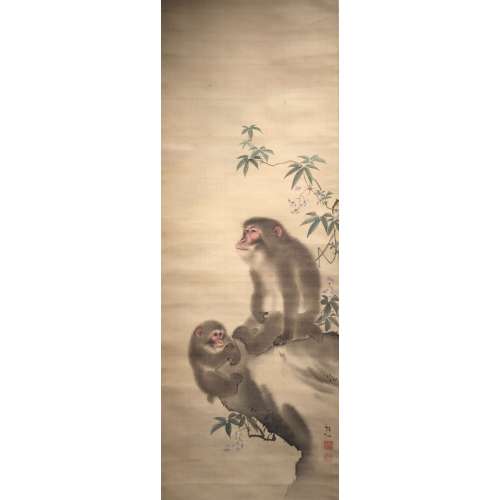 Mori Sosen (1747-1821). A Monkey Seated on a Rock with an Infant Monkey. Hanging scroll painting. Ink and colour on silk. Signed: Sosen. Sealed: Sosen. 108.3 x 38.3 cm. Provenance: According to the box inscriptions, the painting was in the possession of Itakura Katsunao, a daimyo lord in present-day Gunma, in 1808. In 1881, the painting was subsequently acquired by Negishi Shôrei (1833-1897) a master swordsman who established the Negishi school of shuriken ("The only specialist school to have survived is the Negishi-ryū, which was founded by Negishi Shorei in the mid-1800s".)
Mori Sosen (1747-1821). A Monkey Seated on a Rock with an Infant Monkey. Hanging scroll painting. Ink and colour on silk. Signed: Sosen. Sealed: Sosen. 108.3 x 38.3 cm. Provenance: According to the box inscriptions, the painting was in the possession of Itakura Katsunao, a daimyo lord in present-day Gunma, in 1808. In 1881, the painting was subsequently acquired by Negishi Shôrei (1833-1897) a master swordsman who established the Negishi school of shuriken ("The only specialist school to have survived is the Negishi-ryū, which was founded by Negishi Shorei in the mid-1800s".) -
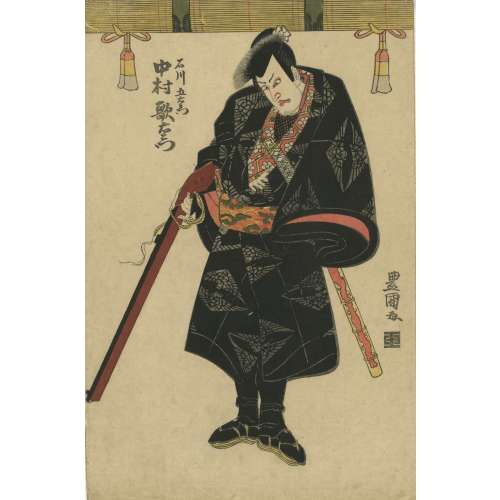 Utagawa Toyokuni (歌川豐國); 1769 – 24 February 1825. The actor Nakamura Utaemon as Ishikawa Goemon. Circa 1810. Size/Format: Oban, 9.75 by 14.5 inches
Utagawa Toyokuni (歌川豐國); 1769 – 24 February 1825. The actor Nakamura Utaemon as Ishikawa Goemon. Circa 1810. Size/Format: Oban, 9.75 by 14.5 inches -
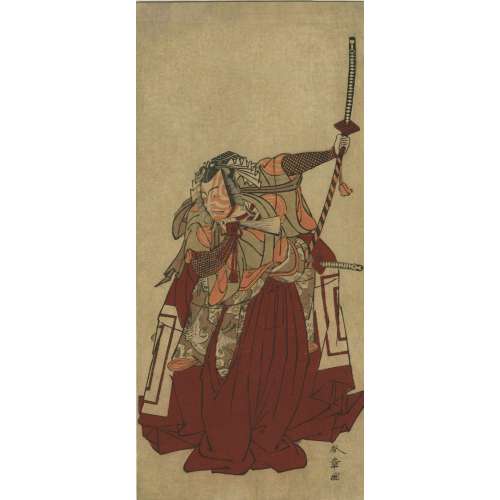 Katsukawa Shunshō ( 勝川 春章; 1726 – 19 January 1793).
Katsukawa Shunshō ( 勝川 春章; 1726 – 19 January 1793).SIZE: 12.5 x 5.75 in.
-
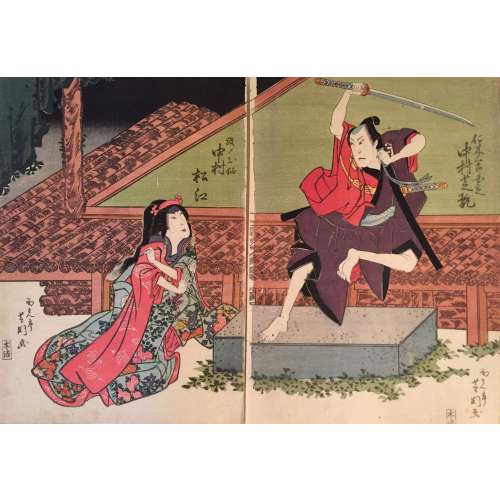 Saikotei Shibakuni (active 1821-1826). Osaka school. Play: Kinoshitakage Hazuma Gassen. Theatre: Nakamura-za /Naka-za (Osaka). Date: 7/1826. Horizontal oban diptych. SV: Nakamura Matsue III (Nakamura Tomijuro II) as female, Nakamura Utaemon III (Nakamura Shikan I) as a male. Publisher: Honya Seishichi [Marks 25-527 | 123f], Honsei, 1817-1838.
Saikotei Shibakuni (active 1821-1826). Osaka school. Play: Kinoshitakage Hazuma Gassen. Theatre: Nakamura-za /Naka-za (Osaka). Date: 7/1826. Horizontal oban diptych. SV: Nakamura Matsue III (Nakamura Tomijuro II) as female, Nakamura Utaemon III (Nakamura Shikan I) as a male. Publisher: Honya Seishichi [Marks 25-527 | 123f], Honsei, 1817-1838. -
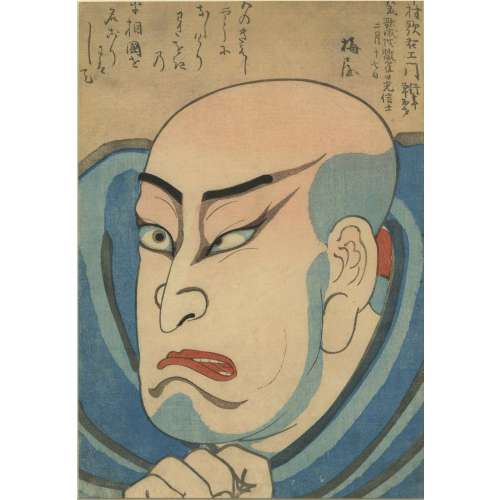 Utagawa Kuniyoshi (attributed to). Memorial portrait (Shini-e, death picture) of Nakamura Utaemon IV (a.k.a. Shikan II) as Taira no Kiyomori (1118-81). Date: 1852. Reference: [LIB-1030.2016] Robert Schaap. Heroes & ghosts: Japanese prints by Kuniyoshi, 1797-1861. — Leiden: Hotei Publishing, 1998; p. 165, image 176. [LIB-3316.2024] Chris Uhlenbeck, Jim Dwinger, Josephine Smit. The Riddles of Ukiyo-e: Women and Men in Japanese Prints. — Brussels: Ludion, 2023; pp. 242-3, № 119. Provenance: Herbert Egenolf Collection, Germany. Literature: Suzuki (1992) 317. Trimmed, unsigned.
Utagawa Kuniyoshi (attributed to). Memorial portrait (Shini-e, death picture) of Nakamura Utaemon IV (a.k.a. Shikan II) as Taira no Kiyomori (1118-81). Date: 1852. Reference: [LIB-1030.2016] Robert Schaap. Heroes & ghosts: Japanese prints by Kuniyoshi, 1797-1861. — Leiden: Hotei Publishing, 1998; p. 165, image 176. [LIB-3316.2024] Chris Uhlenbeck, Jim Dwinger, Josephine Smit. The Riddles of Ukiyo-e: Women and Men in Japanese Prints. — Brussels: Ludion, 2023; pp. 242-3, № 119. Provenance: Herbert Egenolf Collection, Germany. Literature: Suzuki (1992) 317. Trimmed, unsigned. -
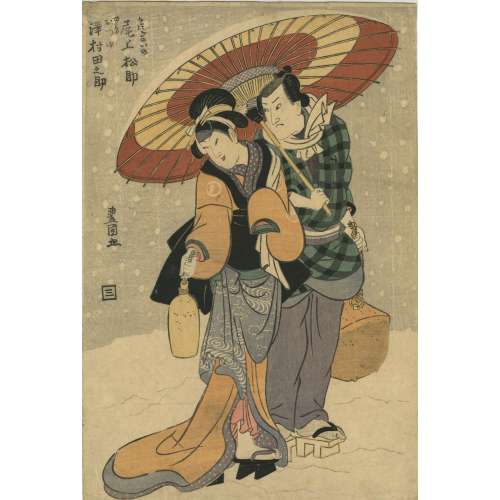 Utagawa Toyokuni (歌川豐國); 1769 – 24 February 1825. Actor Onoe Matsusuke II as Katsugiino (right), actor Sawamura Tanosuke II as Otsuyu (left) 尾上松助(二代目)in a role かつぎいの; 沢村田之助(二代目) in a role おつゆ. Play: "Yuki to Tsuki Hana no Kuronushi". Theater: Nakamura. Publisher: Mikawaua Seiemon (1805-1829) [Marks: 328]. Circa 1810.
Utagawa Toyokuni (歌川豐國); 1769 – 24 February 1825. Actor Onoe Matsusuke II as Katsugiino (right), actor Sawamura Tanosuke II as Otsuyu (left) 尾上松助(二代目)in a role かつぎいの; 沢村田之助(二代目) in a role おつゆ. Play: "Yuki to Tsuki Hana no Kuronushi". Theater: Nakamura. Publisher: Mikawaua Seiemon (1805-1829) [Marks: 328]. Circa 1810. -
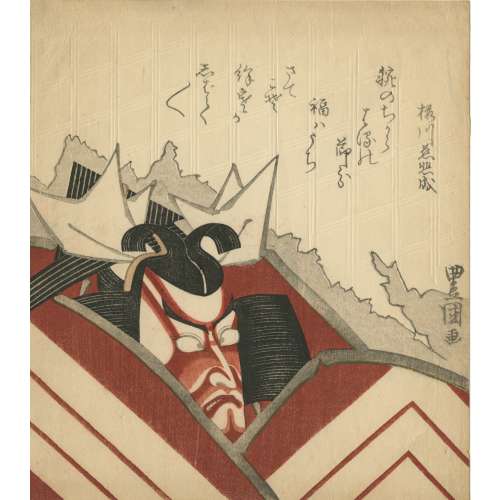 UTAGAWA TOYOKUNI I (1769–1825) Ichikawa Danjūrō VII (Ebizo V) in a shibaraku costume bursting through a paper screen. Surimono. Colour woodblock print: shikishiban, 8⅛ x 7⅛ in. (20.7 x 18.2 cm) Signed: Toyokuni ga Poem signed: Sakuragawa Jihinari Provenance: Sidney C. Ward
UTAGAWA TOYOKUNI I (1769–1825) Ichikawa Danjūrō VII (Ebizo V) in a shibaraku costume bursting through a paper screen. Surimono. Colour woodblock print: shikishiban, 8⅛ x 7⅛ in. (20.7 x 18.2 cm) Signed: Toyokuni ga Poem signed: Sakuragawa Jihinari Provenance: Sidney C. Ward -
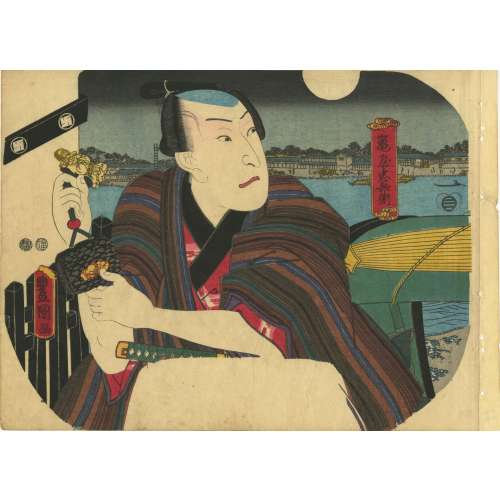 Artist: Utagawa Kunisada [歌川 国貞] a.k.a. Utagawa Toyokuni III [三代歌川豊国] (Japanese, 1786 – 1865). Signed: Toyokuni ga [豊国 画] in a red toshidama cartouche. Actor: Sawamura Gennosuke II [沢村源之助] (Japanese, 1802/7 – 1853); other names: Suketakaya Takasuke III, Sawamura Chōjūrō V [沢村長十郎], Sawamura Tosshō I, Sawamura Genpei I. Character: Kameya Chubei [亀屋忠兵衛] Play: Koi Bikyaku Yamato Orai [恋飛脚大和往来] Performance: Kawarasaki Theatre [河原崎座] in the 2nd month of 1851. Double nanushi censor seals: Fuku & Muramatsu, from 3rd month of Kaei 2 to 11th month of Kaei 4 (1849-51). Another fan print from the pair SVJP-0212-1.2016: Ichikawa Ebizō V as Tanbaya Onizo / Fan print, 1851.
Artist: Utagawa Kunisada [歌川 国貞] a.k.a. Utagawa Toyokuni III [三代歌川豊国] (Japanese, 1786 – 1865). Signed: Toyokuni ga [豊国 画] in a red toshidama cartouche. Actor: Sawamura Gennosuke II [沢村源之助] (Japanese, 1802/7 – 1853); other names: Suketakaya Takasuke III, Sawamura Chōjūrō V [沢村長十郎], Sawamura Tosshō I, Sawamura Genpei I. Character: Kameya Chubei [亀屋忠兵衛] Play: Koi Bikyaku Yamato Orai [恋飛脚大和往来] Performance: Kawarasaki Theatre [河原崎座] in the 2nd month of 1851. Double nanushi censor seals: Fuku & Muramatsu, from 3rd month of Kaei 2 to 11th month of Kaei 4 (1849-51). Another fan print from the pair SVJP-0212-1.2016: Ichikawa Ebizō V as Tanbaya Onizo / Fan print, 1851.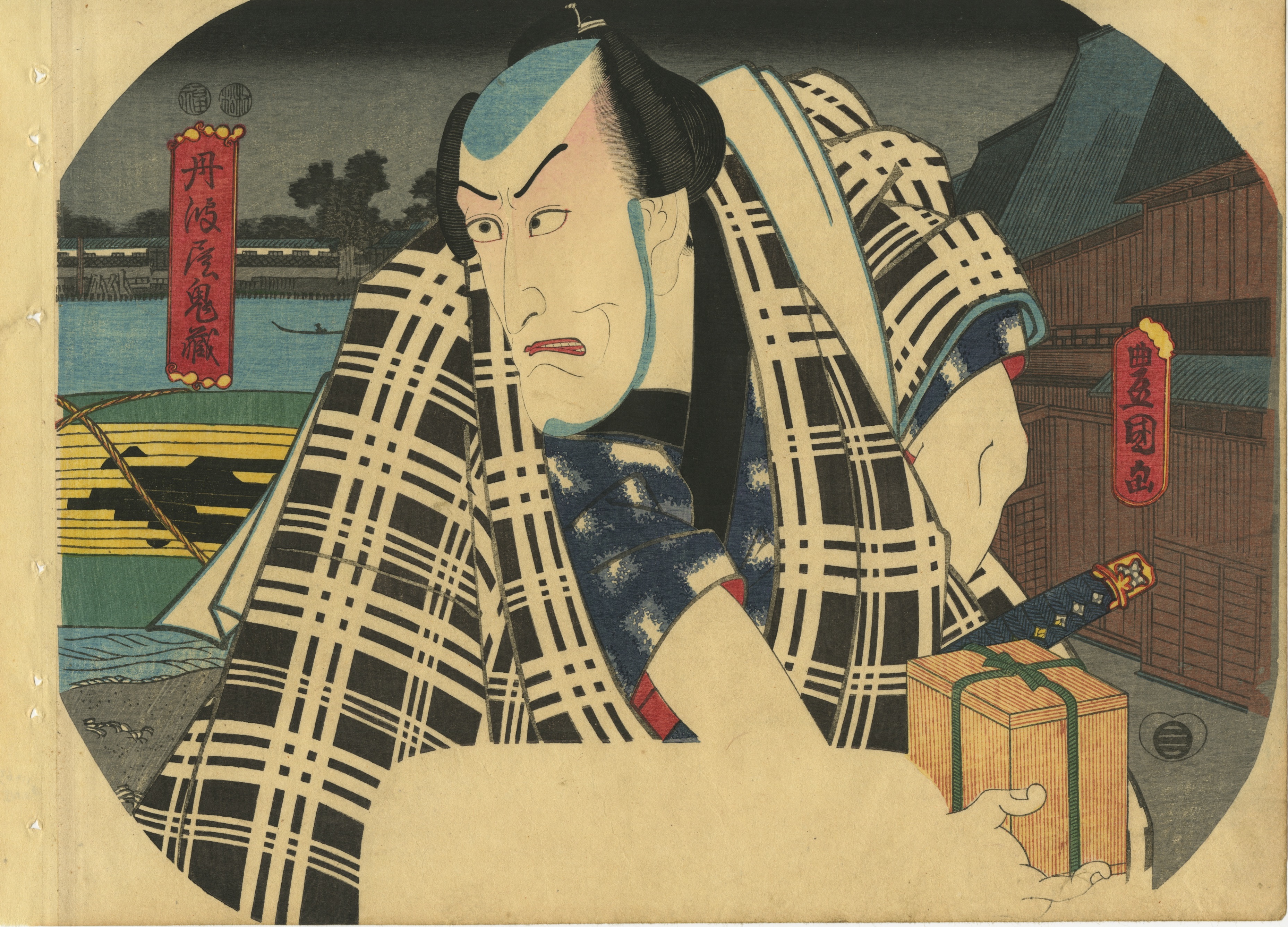
-
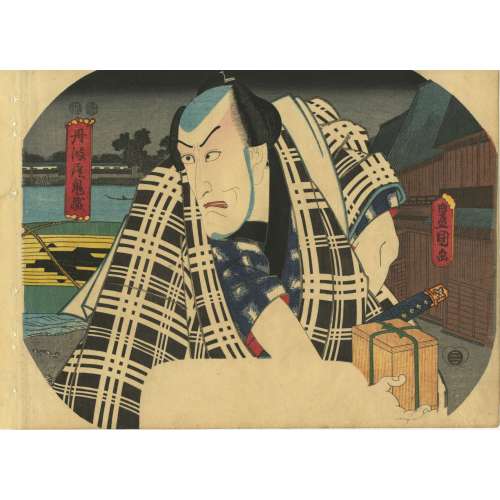 Artist: Utagawa Kunisada [歌川 国貞] a.k.a. Utagawa Toyokuni III [三代歌川豊国] (Japanese, 1786 – 1865). Signed: Toyokuni ga [豊国 画] in a red toshidama cartouche. Actor: Ichikawa Danjūrō VII 市川団十郎 (Japanese, 1791 – 1859); other names: Ichikawa Ebizō V, Ichikawa Hakuen II, Ichikawa Shinnosuke I. Character: Tanbaya Onizo [丹波屋鬼蔵] Play: Koi Bikyaku Yamato Orai [恋飛脚大和往来] Performance: Kawarasaki Theatre [河原崎座] in the 2nd month of 1851. Double nanushi censor seals: Fuku & Muramatsu, from 3rd month of Kaei 2 to 11th month of Kaei 4 (1849-51). Another fan print from the pair SVJP-0212-2.2016: Sawamura Chōjūrō V as Kameya Chubei.
Artist: Utagawa Kunisada [歌川 国貞] a.k.a. Utagawa Toyokuni III [三代歌川豊国] (Japanese, 1786 – 1865). Signed: Toyokuni ga [豊国 画] in a red toshidama cartouche. Actor: Ichikawa Danjūrō VII 市川団十郎 (Japanese, 1791 – 1859); other names: Ichikawa Ebizō V, Ichikawa Hakuen II, Ichikawa Shinnosuke I. Character: Tanbaya Onizo [丹波屋鬼蔵] Play: Koi Bikyaku Yamato Orai [恋飛脚大和往来] Performance: Kawarasaki Theatre [河原崎座] in the 2nd month of 1851. Double nanushi censor seals: Fuku & Muramatsu, from 3rd month of Kaei 2 to 11th month of Kaei 4 (1849-51). Another fan print from the pair SVJP-0212-2.2016: Sawamura Chōjūrō V as Kameya Chubei.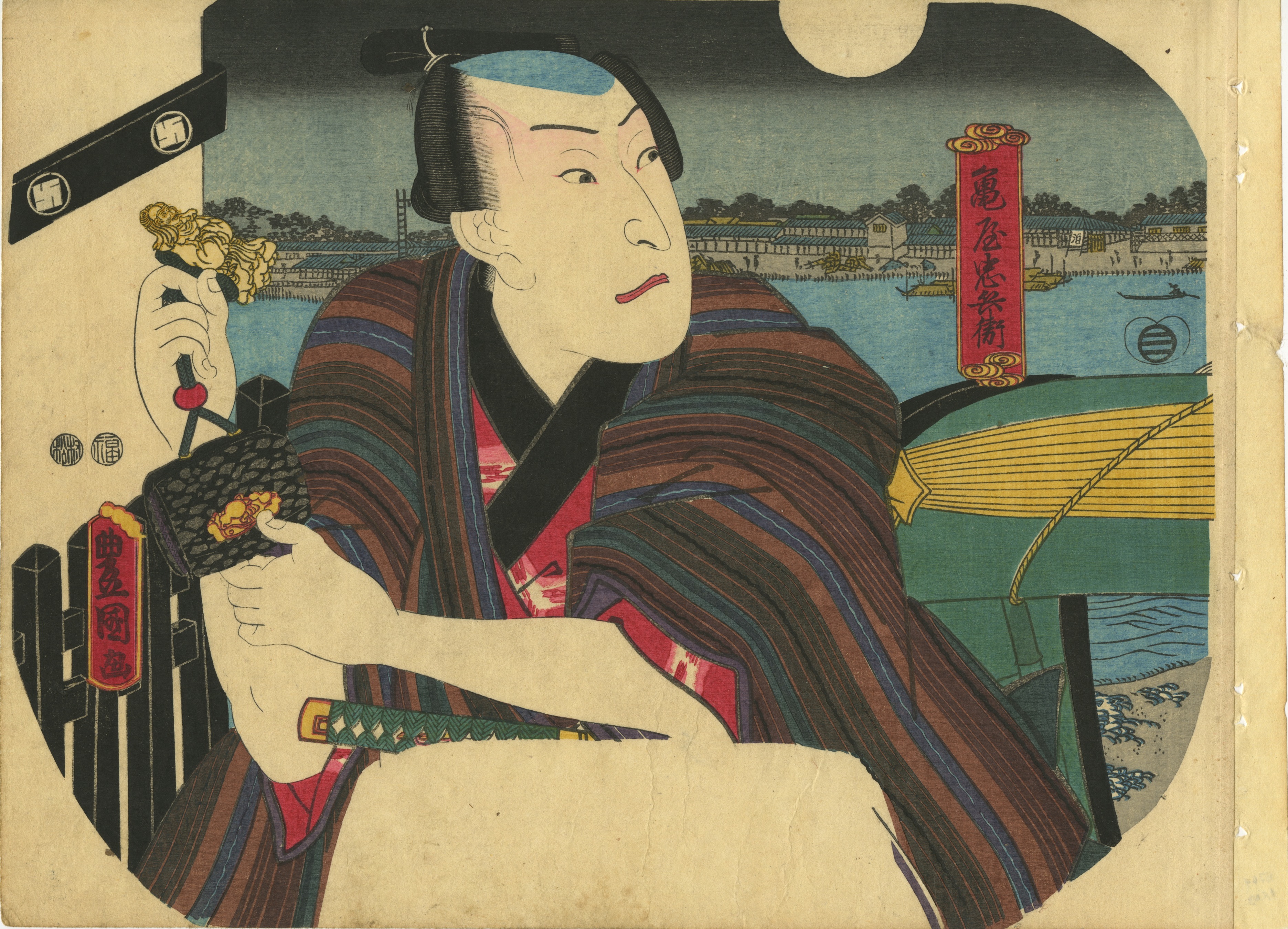
-
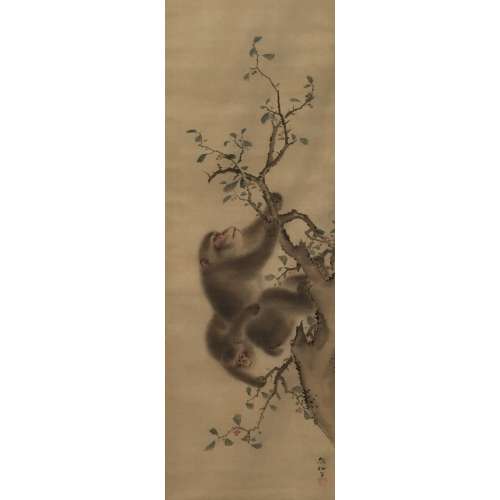 Mori Sosen (1747-1821). Two Monkeys Hanging From Branches. Hanging Scroll Painting. Ink and colour on silk. Signed: Sosen. Sealed: Sosen.
Mori Sosen (1747-1821). Two Monkeys Hanging From Branches. Hanging Scroll Painting. Ink and colour on silk. Signed: Sosen. Sealed: Sosen.


